Get in Touch With Attiroof
For top-tier, custom roofing solutions, trust Attiroof. Our commitment to quality and service is unmatched. Reach out to start your project today.
Mar. 05, 2024
Roof Tile Maintenance
Discover the transformative power of synthetic resin tiles, a groundbreaking choice for contemporary roofing. This guide offers a deep dive into their robust durability, aesthetic versatility, and eco-friendly benefits, equipping you with the essentials for a well-informed roofing decision.
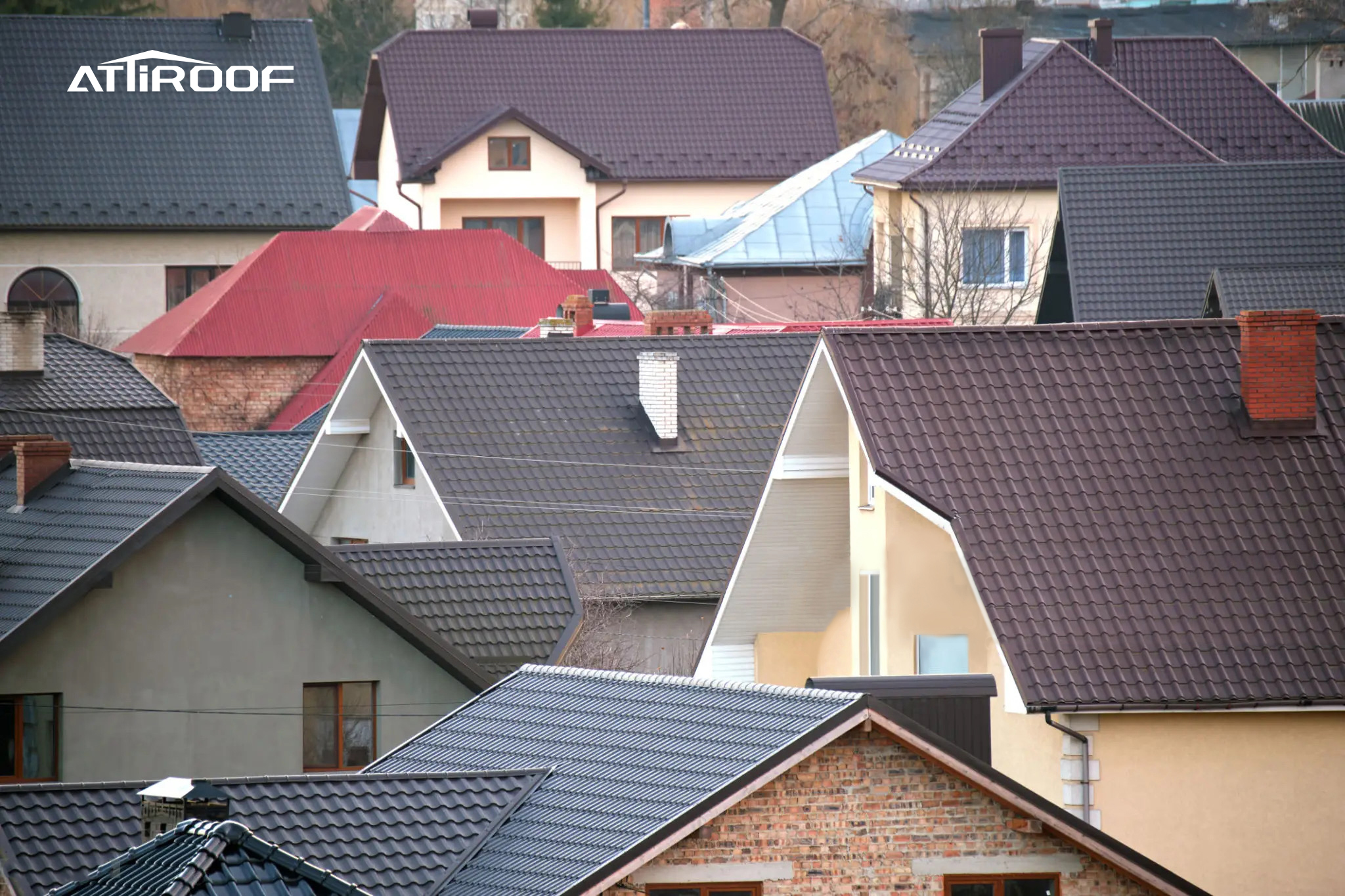
In recent years, the roofing industry has witnessed a significant shift towards more innovative and sustainable materials, with synthetic resin tiles at the forefront of this change. These tiles, known for their exceptional durability and aesthetic flexibility, are rapidly becoming a top choice for homeowners and builders alike. This surge in popularity is not just a trend but a response to the evolving demands of modern construction – demands for materials that are not only visually appealing but also environmentally responsible and functionally superior.
The preference for synthetic resin tiles is strongly backed by market data and consumer trends. A recent industry report revealed that the global market for synthetic resin roofing is expected to grow at a Compound Annual Growth Rate (CAGR) of approximately 3.5% over the next five years. This growth is largely driven by increasing consumer demand for durable and environmentally friendly building materials.
Consumer surveys indicate that over 60% of homeowners and builders now consider environmental impact as a critical factor in their roofing material selection. Synthetic resin tiles meet this demand by offering significant environmental benefits – they are commonly made from recycled materials and are 100% recyclable at the end of their lifecycle, reducing landfill waste.
Furthermore, the demand for energy-efficient homes is on the rise. Data from energy sector studies show that roofing materials like synthetic resin tiles can improve a home's energy efficiency by up to 20%. This is due to their reflective properties, which reduce heat absorption and thus lower cooling costs in warmer climates.
Design flexibility is another key factor. A survey of architects and builders indicated that approximately 70% prefer materials that offer a range of aesthetic options. Synthetic resin tiles are available in various colors and styles, making them adaptable to different architectural designs, from modern to traditional.
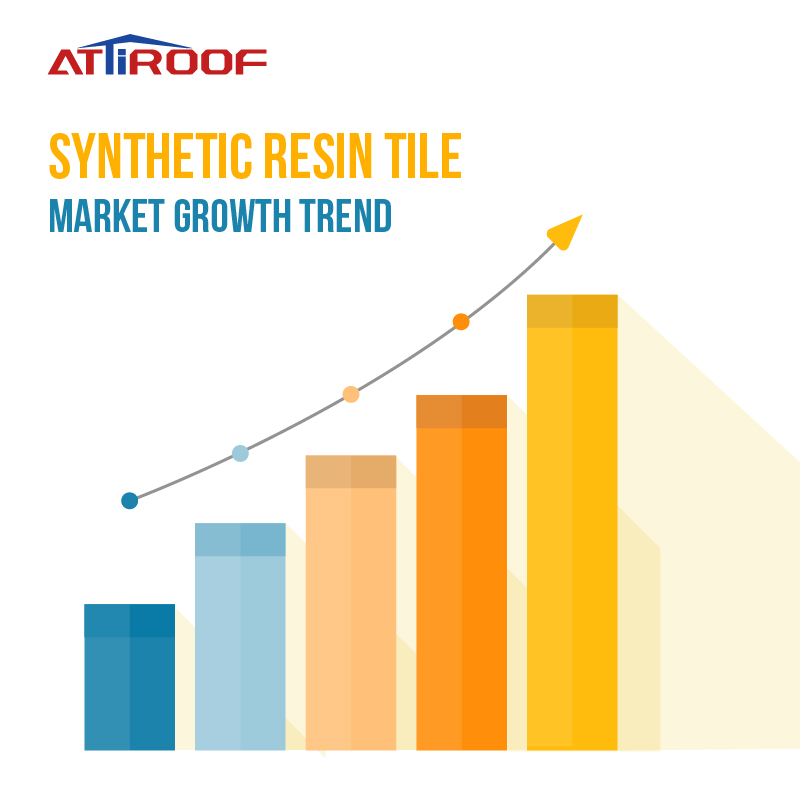
In summary, the market trends and consumer preferences clearly indicate a shift towards roofing solutions that are durable, eco-friendly, and aesthetically versatile. Synthetic resin tiles, with their ability to meet these diverse requirements, are rightly positioned as a leading choice in the roofing materials market.
When evaluating the growing popularity of synthetic resin tiles, it's crucial to understand how they stack up against traditional roofing materials like clay, concrete, and slate. This comparison highlights why an increasing number of consumers and builders are turning towards synthetic resin options.
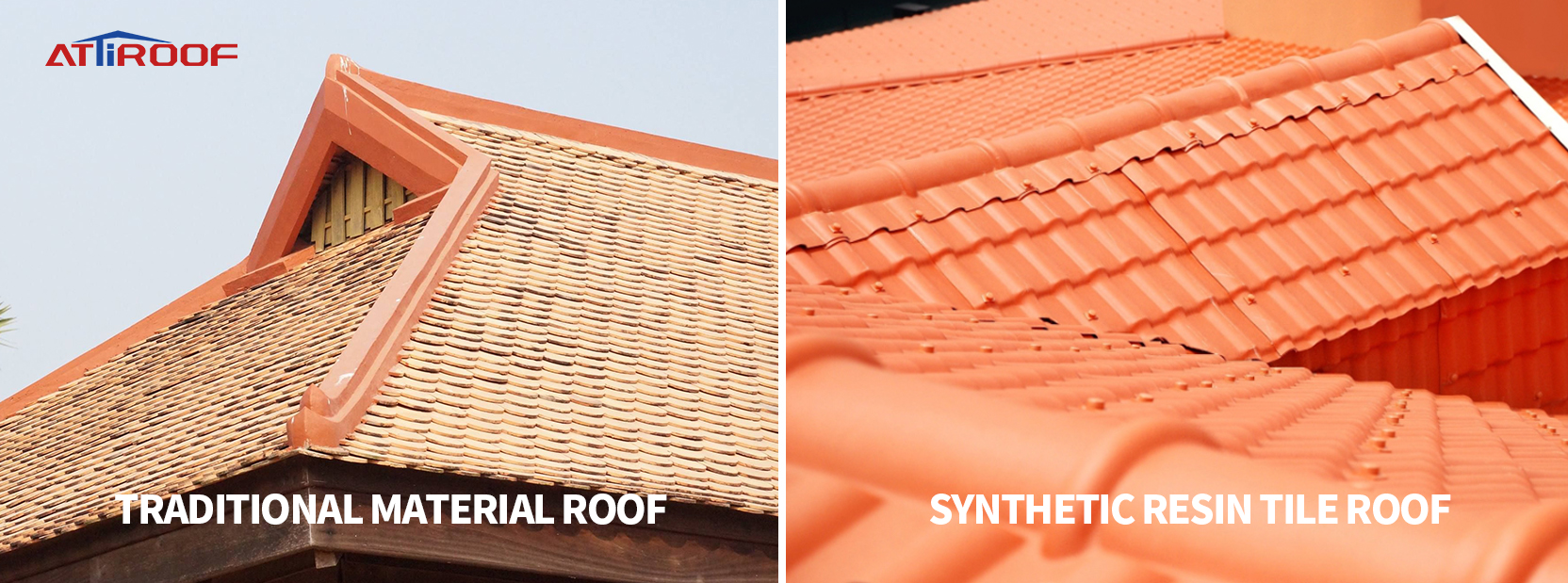
●Durability and Lifespan
Traditional materials such as slate are known for their longevity, but synthetic resin tiles offer comparable, if not superior, durability. While materials like clay and concrete can be prone to cracking and erosion over time, synthetic resin tiles are engineered to resist such wear and tear, often boasting a lifespan that can exceed 50 years with minimal maintenance.
●Weight
One of the significant advantages of synthetic resin tiles is their lightweight nature. Traditional materials like slate and concrete are considerably heavier, which can require additional structural support. This added weight increases the complexity and cost of both installation and maintenance. In contrast, the lightweight nature of synthetic resin tiles makes them easier and less expensive to install and maintain.
●Environmental Impact
In today's eco-conscious market, the environmental impact of building materials is increasingly important. Traditional roofing materials, while durable, often have a larger carbon footprint in terms of both production and transportation. Synthetic resin tiles, on the other hand, are often made from recycled materials and are fully recyclable, which significantly reduces their environmental impact.
●Aesthetics and Variety
While traditional materials offer aesthetic appeal, they are sometimes limited in terms of color and design variety. Synthetic resin tiles provide a broader range of colors and styles, allowing for greater flexibility in meeting diverse architectural styles and personal preferences.
●Cost-Effectiveness
Initially, traditional materials like slate might seem cost-effective due to their longevity. However, when considering the total lifecycle costs, including installation, maintenance, and potential repairs, synthetic resin tiles often emerge as a more cost-effective solution in the long run.
In summary, synthetic resin tiles offer several compelling advantages over traditional roofing materials, including enhanced durability, lighter weight, lower environmental impact, greater aesthetic variety, and overall cost-effectiveness. These factors contribute significantly to their increasing popularity in the roofing market.
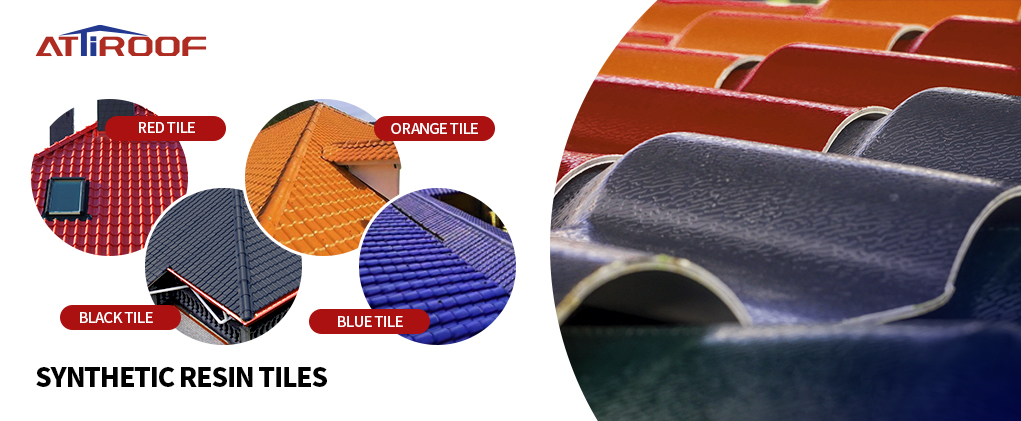
Synthetic resin tiles are revolutionizing the roofing industry, offering a blend of durability, aesthetic appeal, and eco-friendliness. But what exactly are these innovative tiles, and how are they brought to life? This section unveils the essence of synthetic resin tiles, exploring their composition and the advanced manufacturing processes that set them apart from traditional roofing materials.
The manufacturing of synthetic resin tiles is a meticulously structured process, ensuring high-quality, durable, and aesthetically pleasing roofing materials. Let’s walk through the nine key stages of production:
1. Raw Material Inspection upon Arrival
The process begins with a thorough inspection of raw materials as they arrive at the factory. This includes checking synthetic resins, UV stabilizers, color pigments, and any other additives for quality and consistency, ensuring they meet the required standards.
2. Batching/Ingredient Mixing
The approved materials are then precisely measured and mixed according to the specific formula. This step is crucial for achieving the desired properties in the final product, such as color, strength, and UV resistance.
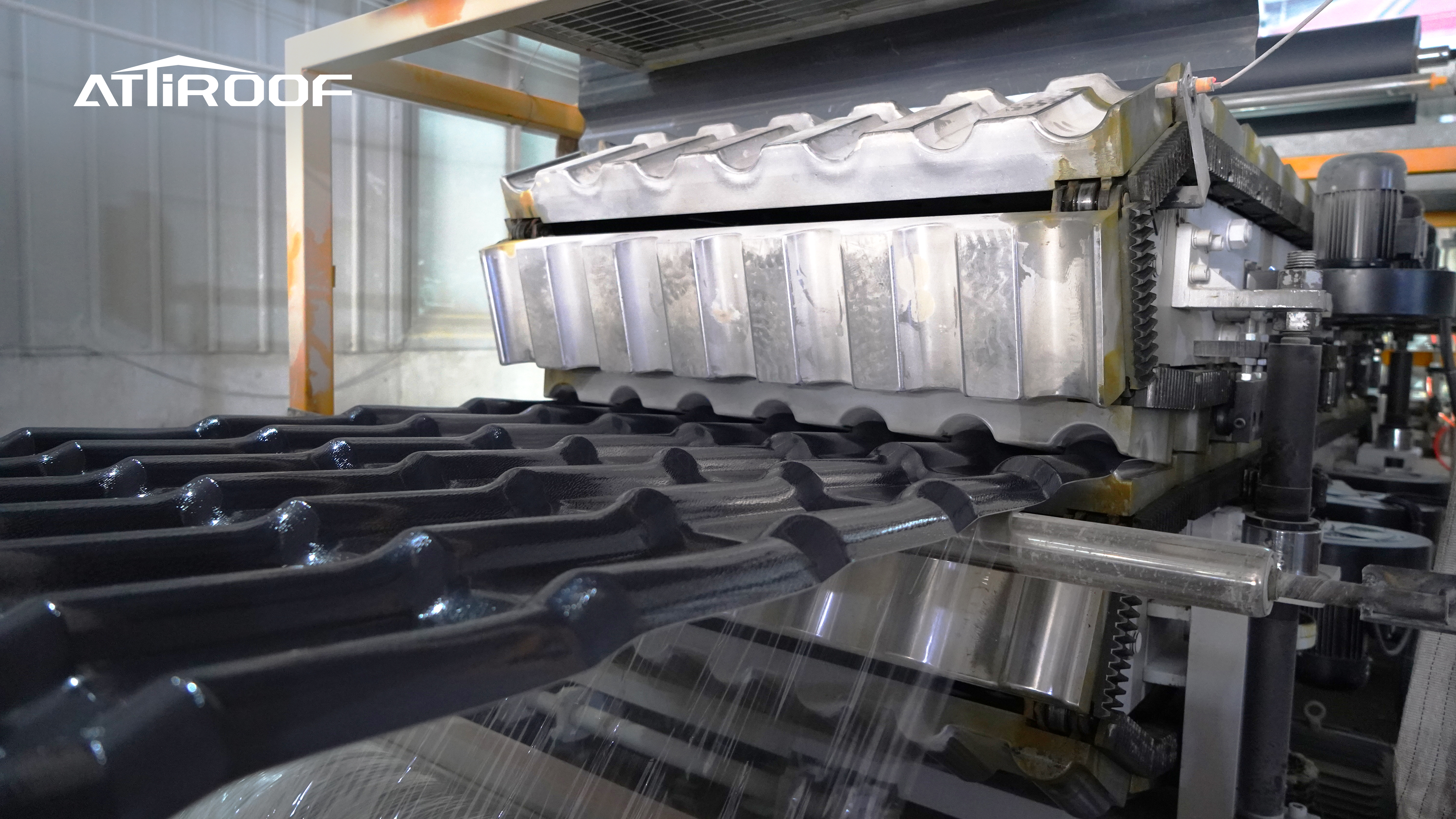
3. Mixing and Plasticizing
In this stage, the combined materials undergo mixing and plasticizing. This process ensures a homogeneous mixture and prepares the material for extrusion by softening it through heating and mechanical work.
4. Extrusion
The plasticized material is fed into an extruder, where it is further melted and pushed through a die to form a continuous sheet or profile in the specific shape of the tiles.
5. Film Lamination
A key step for enhancing the tile's aesthetic and functional properties, film lamination involves applying a protective layer to the extruded material. This film can provide additional UV protection, color, or texture.
6. Molding and Cooling
The tiles are then shaped using a molding machine and cooled to solidify and stabilize their form. This process is critical for ensuring the tiles have the right shape and mechanical properties.
7. Cutting
After cooling, the continuous tile profile is cut into individual tiles of the desired size. Precision cutting ensures uniformity and consistency in tile dimensions.
8. Inspection
Each tile undergoes a rigorous quality inspection to check for defects, dimensional accuracy, and overall quality. This step is vital to maintain high standards and meet customer expectations.
9. Packaging and Storage
Finally, the inspected tiles are carefully packaged, ensuring they are protected during transportation and storage. The packaged tiles are then stored in the warehouse, ready for distribution and installation in various projects.
Through this detailed nine-step process, synthetic resin tiles are crafted with a focus on quality, durability, and aesthetics. Each step, from the initial raw material inspection to the final packaging, is designed to ensure that the tiles meet the high standards expected by consumers and the industry, making them a superior choice for modern roofing solutions.
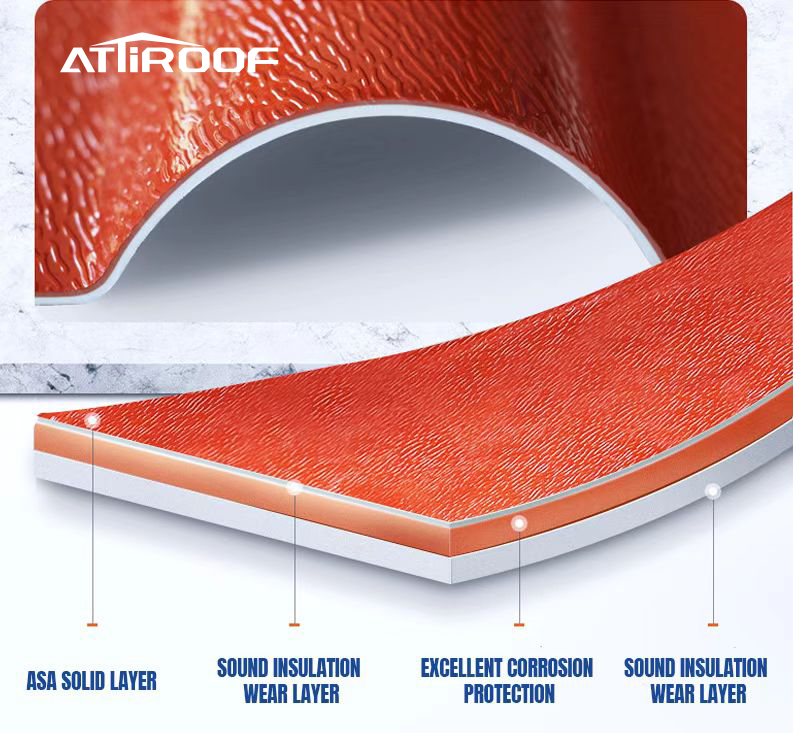
The excellence of synthetic resin tiles lies in their sophisticated blend of advanced materials and cutting-edge technology, which together create a roofing material superior in durability, functionality, and aesthetics.
Multi-Layered Structure and Materials:
1. Top Layer (ASA Solid Color Layer): Utilizes Acrylonitrile Styrene Acrylate (ASA), known for superb weatherability. This layer ensures long-lasting color vibrancy and resistance to UV rays, aging, and chemical corrosion.
2. Sound Insulation and Wear Resistance Layers (Second and Fourth Layers): These layers enhance the tile's acoustic properties and add durability, making the tiles ideal for various environmental conditions.
3. Anti-Corrosion Layer (Third Layer): Specifically designed for high resistance to chemical and environmental corrosion, protecting the tile over its lifespan.
Advanced Manufacturing Technologies:
●Precision Extrusion and Molding: State-of-the-art extrusion and molding techniques are employed to ensure uniformity and consistency in tile shapes and sizes.
●ASA Lamination Technology: A specialized technique used to apply the ASA layer, ensuring strong bonding and longevity of the topcoat.
●Automated Mixing and Batching Systems: These systems ensure precise formulation of the tile material, maintaining consistency in quality across batches.
Key Formulation Components:
1. PVC Resin: Provides the primary structure of the tiles, known for its strength and durability.
2. Ultrafine Calcium Carbonate: Acts as a filler to enhance the tile's structural integrity and cost-efficiency.
3. Heat Stabilizers, Impact Modifiers, and Lubricants (PVC Stabilizer, CPE/ACR, Stearic Acid, PE Wax): These additives play crucial roles in enhancing the processing, durability, and performance of the tiles.
4. Titanium Dioxide and ASA Super Weather-Resistant Film: Provide enhanced UV protection, color stability, and surface resilience, contributing to the tile's aesthetic and functional longevity.
This combination of high-grade materials and innovative technologies positions synthetic resin tiles as a cutting-edge solution in the roofing industry. Not only do they offer superior performance and aesthetic appeal, but they also reflect a commitment to sustainability and technological advancement.
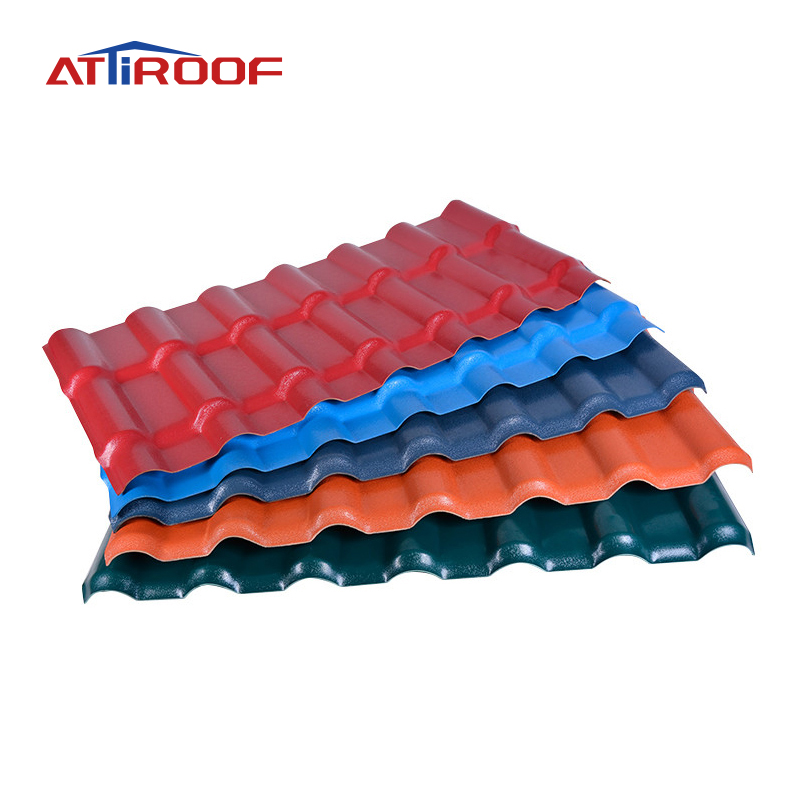 As the construction industry evolves, synthetic resin roof tiles are increasingly becoming the preferred choice for modern roofing solutions. Their rising popularity is not without reason; these tiles offer a host of advantages that far surpass traditional roofing materials. From unparalleled longevity to environmental sustainability, synthetic resin tiles provide homeowners and builders with both practical and aesthetic benefits. This section delves into the key advantages that make synthetic resin roof tiles an exemplary choice in today’s roofing market.
As the construction industry evolves, synthetic resin roof tiles are increasingly becoming the preferred choice for modern roofing solutions. Their rising popularity is not without reason; these tiles offer a host of advantages that far surpass traditional roofing materials. From unparalleled longevity to environmental sustainability, synthetic resin tiles provide homeowners and builders with both practical and aesthetic benefits. This section delves into the key advantages that make synthetic resin roof tiles an exemplary choice in today’s roofing market.
Synthetic resin roof tiles are distinguished for their remarkable longevity and resistance to decay, supported by compelling data and research:
●Enhanced Durability: Studies show that synthetic resin tiles can last up to 50 years or more, far exceeding the lifespan of traditional materials like asphalt shingles, which typically last between 15 to 30 years. This extended lifespan is attributed to the high-grade synthetic resins used, which are engineered for endurance.
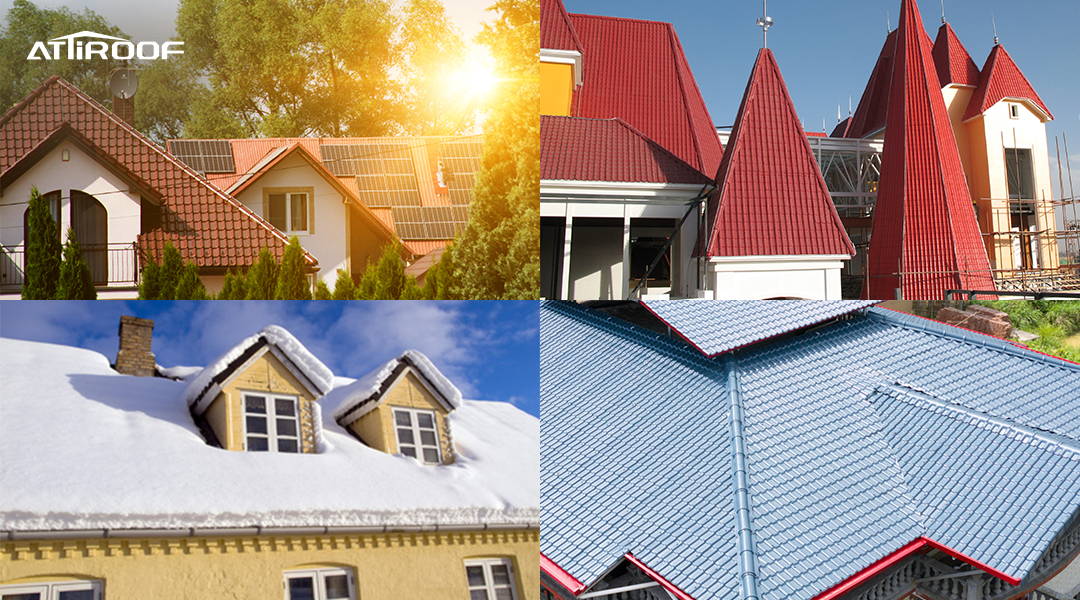
●Superior Resistance to Environmental Elements: Research indicates that synthetic resin tiles maintain their integrity and appearance in various climatic conditions. They are proven to withstand wind speeds of over 100 miles per hour and are highly resistant to hail damage, a common pitfall for many roofing materials.
●Reduced Maintenance Costs: Due to their robust composition, these tiles require significantly less maintenance over their lifespan. Industry reports suggest that homeowners can save up to 60% in maintenance and replacement costs over a 30-year period compared to traditional roofing materials.
●UV Protection Efficiency: The UV inhibitors integrated into the resin material have been shown to block over 99% of harmful UV rays. This high level of UV resistance ensures that the tiles do not degrade or lose color, as evidenced by color stability tests conducted under accelerated weathering conditions.
A significant advantage of synthetic resin roof tiles is their weight benefit compared to traditional roofing materials. This advantage plays a crucial role in both the installation process and the overall structural integrity of buildings.
●Lightweight Nature: Synthetic resin tiles are significantly lighter than traditional materials like clay, concrete, or slate. For example, while traditional clay or concrete tiles can weigh as much as 600 to 800 pounds per square (100 square feet), synthetic resin tiles often weigh just around 200 to 350 pounds per square. This drastic reduction in weight translates to easier handling and faster installation.
●Reduced Structural Stress: The lightweight characteristic of these tiles imposes less stress on the building's structure. This is particularly beneficial for older buildings undergoing roof replacements, as they may not be engineered to support the heavy load of traditional materials.
●Cost-Effective Installation: Due to their lighter weight, synthetic resin tiles require less labor and time to install. This not only speeds up the construction process but also results in lower installation costs. The reduced weight also means that transportation and handling costs are lower, making them more economical.
●Safety During Severe Weather: The lighter weight contributes to safety during severe weather conditions. Heavier tiles can become hazardous in extreme conditions, such as during an earthquake or severe storm, where they might dislodge. Synthetic resin tiles are less likely to pose such risks due to their lighter nature.
In summary, the weight advantage of synthetic resin roof tiles offers multiple benefits, ranging from ease of installation and reduced structural burden to cost savings and increased safety. This makes them a practical and efficient choice for both new constructions and renovation projects.
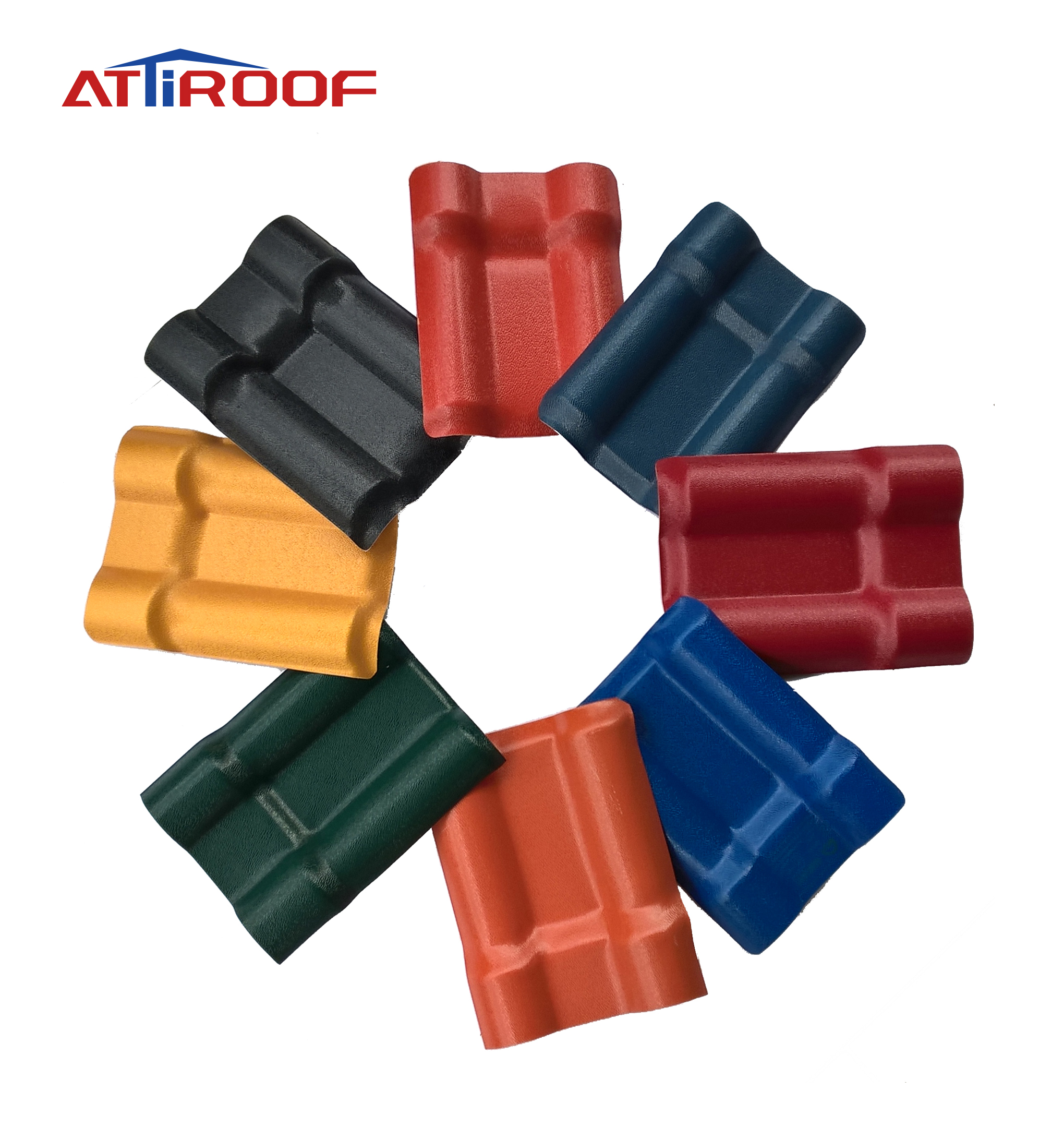 One of the standout advantages of synthetic resin roof tiles is their versatility in design and color, which allows them to cater to a wide array of architectural styles and personal preferences.
One of the standout advantages of synthetic resin roof tiles is their versatility in design and color, which allows them to cater to a wide array of architectural styles and personal preferences.
●Wide Range of Colors: Synthetic resin tiles come in an extensive palette of colors, from traditional shades to bold and contemporary hues. This variety ensures that there's a perfect match for every building's aesthetic. Whether homeowners prefer classic terra cotta, sleek slate gray, or vibrant blues and greens, there's a color option available.
●Diverse Design Options: Beyond color, these tiles offer a variety of shapes and textures. They can mimic the appearance of traditional materials like clay, slate, or wood shakes, providing the aesthetic appeal of these materials without the associated drawbacks. This versatility enables architects and designers to achieve the desired look, be it a rustic charm or a modern elegance, without compromising on performance.
●Customization Flexibility: The manufacturing process of synthetic resin tiles allows for a high degree of customization. Homeowners and builders can choose from different tile sizes, profiles, and finishes to create a unique roof that complements the overall design of the building. Attiroof tiles are also available in various profiles, including small wave, large wave, and trapezoidal shapes, to accommodate different roof slopes and aesthetic preferences. These options ensure that every roofing project achieves a distinctive look with a personal touch.
●Consistent Appearance: Unlike natural materials that can vary in color and texture, synthetic resin tiles offer consistency in appearance. This uniformity ensures that the roof will look cohesive, enhancing the property's curb appeal.
●Adaptability to Various Architectural Styles: Thanks to their design flexibility, these tiles are suitable for a wide range of architectural styles, from traditional homes to contemporary commercial buildings. They can adapt to various roof designs, including complex shapes and steep pitches, providing an ideal solution for both new constructions and renovations.
Synthetic resin roof tiles are at the forefront of the green building movement, offering environmental benefits that are reshaping the roofing industry. These advantages make them an increasingly popular choice for those seeking to reduce their ecological footprint.
●Recyclable Materials: Made from recyclable components, synthetic resin tiles support the circular economy. At the end of their long service life, these tiles can be recycled into new products, reducing waste and the demand for raw materials.
●Energy Efficient: Their reflective properties contribute to lower heat absorption, promoting cooler interiors. This natural insulation means less reliance on air conditioning, leading to energy conservation and reduced greenhouse gas emissions.
●Sustainable Manufacturing: The production of synthetic resin tiles typically requires less energy compared to traditional roofing materials, resulting in a lower carbon footprint for the manufacturing process.
●Durability and Maintenance: The long lifespan and minimal maintenance reduce the need for frequent replacements and repairs, which in turn decreases the consumption of resources and energy over time.
●Water Conservation: The production process of these tiles generally uses less water than traditional roofing materials, contributing to water conservation efforts. Additionally, the smooth surface of synthetic resin tiles is conducive to efficient rainwater harvesting.
Synthetic resin roof tiles embody the principles of environmental sustainability, combining functionality with responsibility. Their incorporation into building design is a step towards more sustainable construction practices that benefit the environment and future generations.
In the face of increasingly erratic weather patterns, the performance of roofing materials under extreme conditions is a paramount concern for homeowners and builders alike. Synthetic resin tiles have been rigorously tested and designed to withstand the harshest of elements. This section examines their resilience and reliability when facing nature’s challenges.
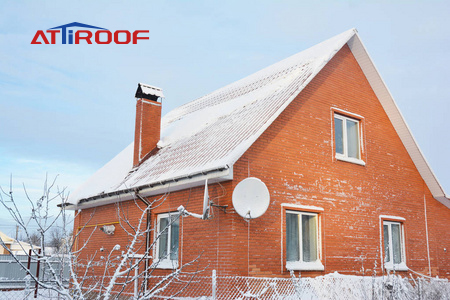
Synthetic resin tiles are designed to stand strong in the diverse climates seen across regions like the snowy peaks of the Rocky Mountains to the heavy rainfall areas along the Gulf Coast.
●Impervious to Heavy Rainfall
In regions known for torrential rains, such as the Pacific Northwest, synthetic resin tiles excel due to their impermeability. They prevent water ingress, protecting homes from the relentless downpours common in these areas.
●Snow and Ice Resilience
The resilience of synthetic resin tiles is particularly evident in cold-weather states like Minnesota and Colorado. Their ability to withstand the weight of heavy snowfall prevents structural compromise, a critical concern in these snowy regions.
●Preventing Ice Dams
In New England, where ice dams are a frequent winter challenge, the design features of synthetic resin tiles help mitigate this risk. The tiles’ smooth surface facilitates the shedding of snow and ice, preventing the buildup that leads to damming.
●Quick Drying Advantage
After wet conditions subside, these tiles dry rapidly, a trait that is especially beneficial in the southern states where quick transitions from rain to sunny conditions can otherwise lead to algae growth on slower-drying materials.
●Hail Impact Durability
In hail-prone areas like Texas, the impact resistance of synthetic resin tiles means they endure through the ice pellets without sustaining damage that would typically lead to leaks or necessitate immediate repairs.
These regional examples underscore the adaptability of synthetic resin tiles to a variety of weather challenges. Their consistent performance in rain and snow across different climate zones affirms their reliability as a top choice for roofing in any location.
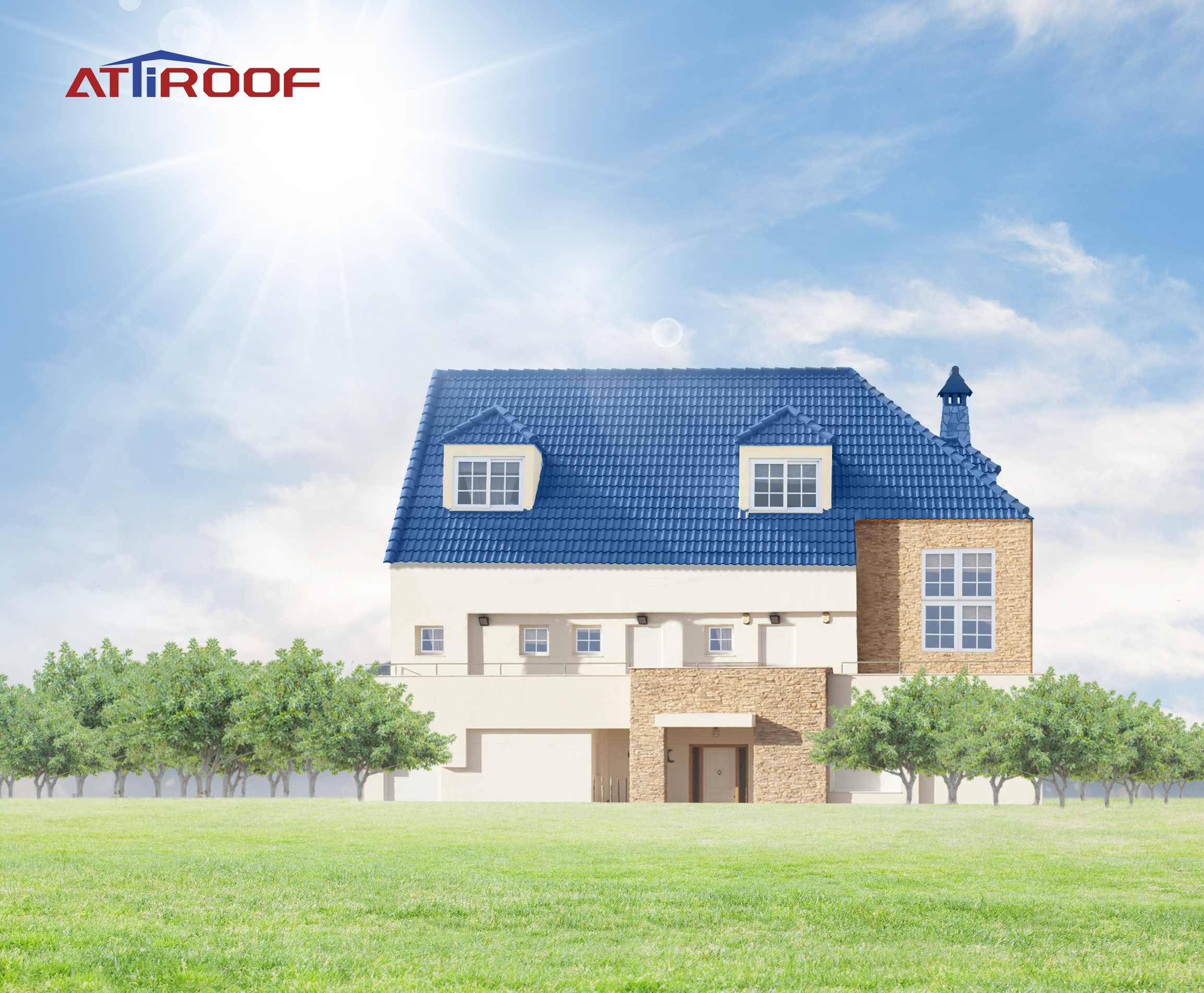
The sun's UV rays can be one of the most relentless forces against roofing materials, causing many to deteriorate prematurely. Synthetic resin tiles, however, are manufactured to combat this:
●UV Stabilization
Synthetic resin tiles incorporate advanced UV inhibitors that absorb and neutralize harmful rays, preventing the breakdown of material and ensuring that the tiles remain strong and intact for decades.
●Color Retention Technology
The color of synthetic resin tiles is not merely surface deep. The pigments used are engineered to be fade-resistant, withstanding UV exposure without significant color change. This is crucial in sun-drenched locales like Florida and Arizona, where the intensity of sunlight is a common cause of color fading.
●Reflective Properties
Many synthetic resin tiles feature reflective coatings that not only protect against UV radiation but also contribute to the energy efficiency of homes by reflecting solar heat away from the roof.
●Laboratory and Field Testing
These tiles have undergone extensive laboratory testing to simulate years of UV exposure, and real-world testing in areas with high solar intensity. Consistently, they show minimal to no degradation, validating their UV resistance claims.
Through cutting-edge materials and technologies, synthetic resin tiles offer a roofing solution that maintains its aesthetic appeal and structural integrity even under the harshest of UV conditions, ensuring that roofs remain vibrant and effective year after year.

Synthetic resin roof tiles are not only aesthetically versatile but also remarkably adaptable to extreme temperature variations, performing with excellence where other materials fail.
●Engineered for Extremes
These tiles have been tested to withstand temperature ranges as broad as -50°C to +80°C(-58°F to +176°F), ensuring their integrity in the scorching heat of desert climates as well as the freezing conditions of arctic environments.
●Thermal Stability
Research indicates that synthetic resin tiles experience minimal thermal expansion. A study showed less than 0.5% dimensional change when subjected to temperature variations, a rate significantly lower than that of conventional roofing materials.
●Heat Endurance
In areas known for high temperatures, such as the American Southwest, synthetic resin tiles have maintained their shape and composition even after prolonged exposure to temperatures exceeding 40°C(104°F), as demonstrated in long-term regional studies.
●Cold Resilience
In cold-weather testing, akin to conditions in the Northern Plains, these tiles have shown no signs of brittleness or cracking at temperatures dropping to -40°C (-40°F), outperforming traditional materials that often require additional measures for cold protection.
The empirical data on synthetic resin tiles highlight their suitability for a range of climates, making them an ideal choice for roofing across diverse geographic areas. Their ability to endure and perform consistently, regardless of thermal stress, underscores their advanced engineering and quality manufacturing.
The quest for more energy-efficient homes is not only about reducing energy costs but also about contributing to a healthier environment. Synthetic resin tiles are emerging as a significant player in the eco-friendly building materials space.
With their unique properties, they are poised to enhance the energy efficiency of homes. This section delves into the ways these innovative tiles contribute to a more sustainable and cost-effective living environment.
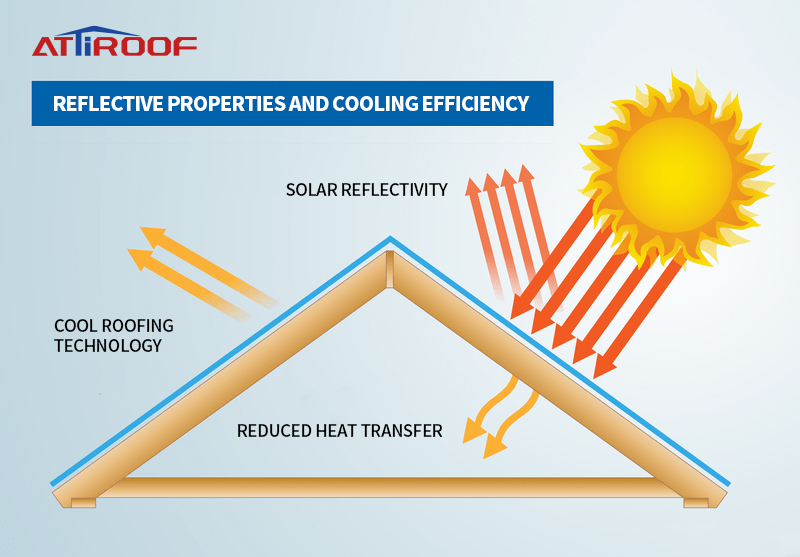
Synthetic resin tiles possess inherent reflective properties that play a crucial role in energy conservation:
●Solar Reflectivity
These tiles are engineered to reflect a substantial portion of solar radiation, rather than absorbing it as heat. This reflectivity is measured by the Solar Reflectance Index (SRI), and synthetic resin tiles have been shown to have high SRI values. For instance, tests conducted in sun-intensive regions like California and Arizona have demonstrated that synthetic resin tiles can reflect up to 70% of the sun's energy.
●Reduced Heat Transfer
By reflecting solar heat, these tiles minimize the heat transfer into the attic and living spaces below, leading to a natural cooling effect. This can significantly lower indoor temperatures during the hot summer months, reducing the reliance on air conditioning systems.
●Cool Roofing Technology
Utilizing cool roofing technology, synthetic resin tiles are at the forefront of green building. They meet and often exceed the ENERGY STAR® requirements for thermal emittance and solar reflectance, which are key criteria for eco-friendly roofing materials.
●Energy Consumption Reduction
The installation of synthetic resin tiles has been associated with a noticeable decrease in energy consumption. Data from energy audits indicate that homes with these tiles can experience up to a 15-20% reduction in cooling costs during peak summer months.
By incorporating synthetic resin tiles into roofing systems, homeowners can take advantage of these reflective properties and cooling efficiencies, leading to not only a more comfortable living space but also a greener and more energy-efficient home.
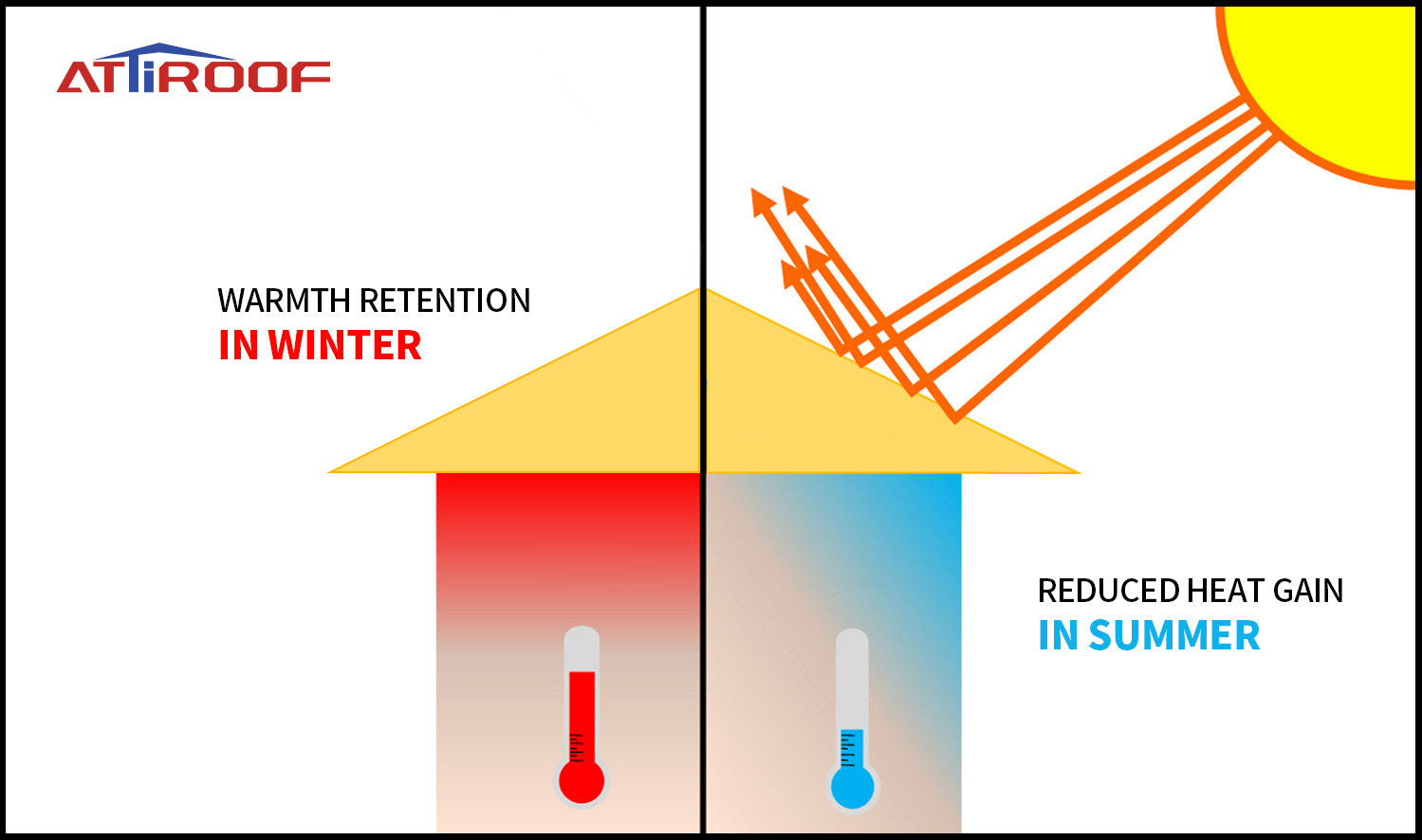
The effectiveness of synthetic resin tiles in enhancing a home's energy efficiency extends beyond their reflective properties. One of the key benefits they offer is improved insulation, which plays a significant role in maintaining a comfortable indoor environment and reducing energy consumption.
●Thermal Insulation
Synthetic resin tiles possess excellent thermal insulation properties. They create a barrier that reduces heat transfer between the exterior environment and the interior of a home. This insulation is particularly effective in maintaining stable indoor temperatures, regardless of the external weather conditions.
●Reduced Heat Gain in Summer
During hot summer months, these tiles significantly reduce the amount of heat that penetrates into the attic and living areas. This means that homes stay cooler naturally, which reduces the burden on air conditioning systems and lowers energy bills.
●Warmth Retention in Winter
Conversely, in colder climates, synthetic resin tiles help to retain warmth within the home. By minimizing heat loss through the roof, they contribute to a warmer interior without over-reliance on heating systems, thereby saving energy and costs associated with heating.
●Impact on Overall Energy Consumption
Studies have shown that homes with synthetic resin roofing can experience a noticeable difference in their energy consumption. For instance, in temperate regions, homeowners have reported up to a 10-15% reduction in energy usage, attributable to the enhanced insulation provided by these tiles.
●Sustainability and Cost-Effectiveness
Beyond immediate energy savings, the long-term sustainability and durability of synthetic resin tiles mean less frequent replacements and repairs, leading to additional environmental and economic benefits.
By improving thermal insulation, synthetic resin tiles offer a practical solution for enhancing the energy efficiency of homes. They not only contribute to a more sustainable and cost-effective lifestyle but also add to the comfort and livability of living spaces.
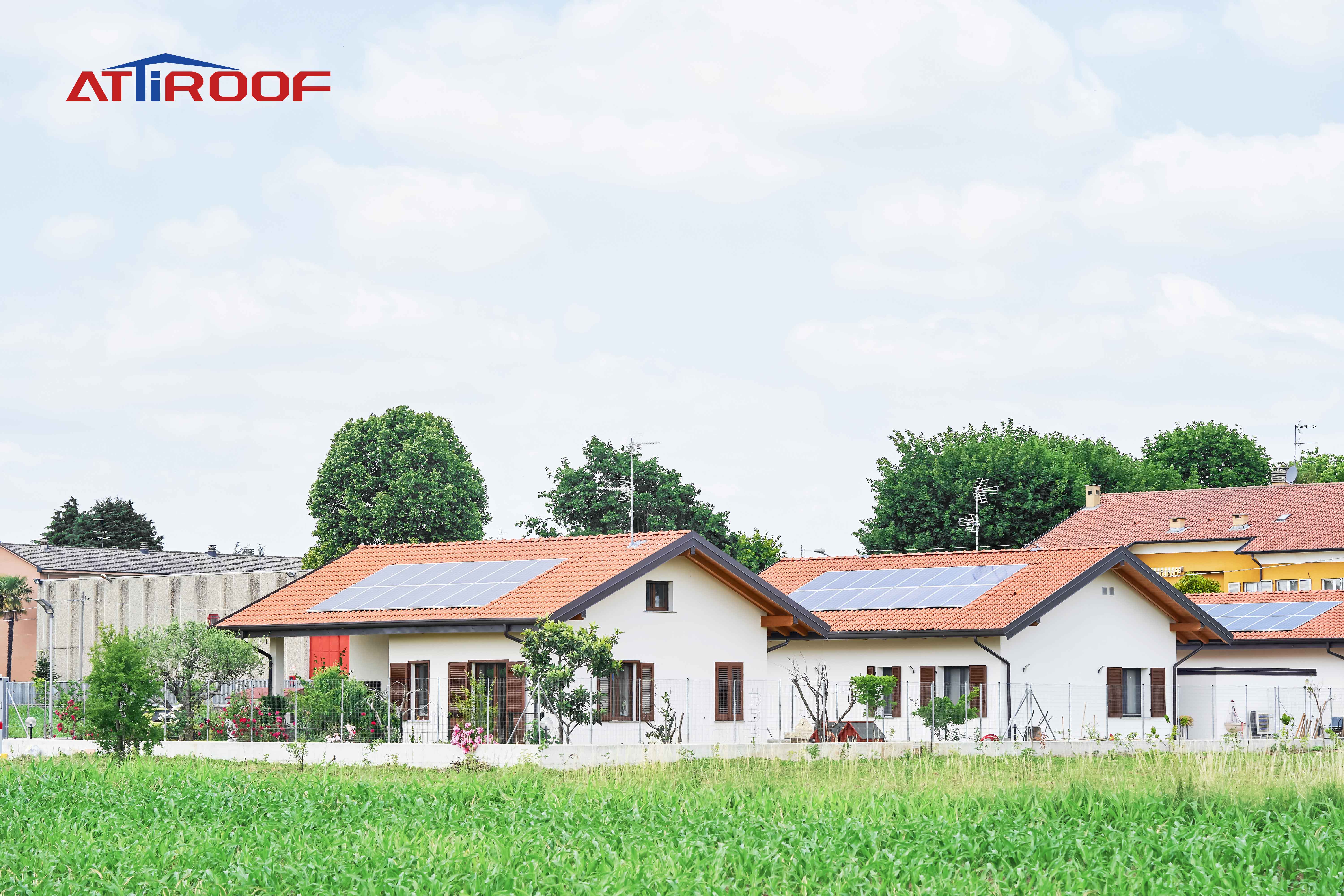
In the pursuit of maximizing a home's energy efficiency, the integration of solar panels with roofing materials is a key consideration. Synthetic resin tiles offer an excellent foundation for solar panel installations, creating a synergy that enhances the overall energy efficiency of homes.
Optimal Base for Solar Panels: Synthetic resin tiles provide a stable and durable surface for mounting solar panels. Their robust construction ensures that they can support the weight and structure of solar panels without compromising the integrity of the roof.
Enhanced Efficiency: The reflective properties of synthetic resin tiles can play a significant role in improving the efficiency of solar panels. By reflecting sunlight onto the panels, these tiles can help increase the amount of solar energy captured, thereby boosting the overall energy production.
Durability Under Solar Panels: The durability and resistance to UV radiation of synthetic resin tiles ensure that they remain intact and effective under solar panels for many years. This longevity is crucial, as solar panel installations are typically a long-term investment.
Temperature Regulation: One of the challenges with solar panels is the heat they generate, which can impact their efficiency. The insulative properties of synthetic resin tiles help to regulate the temperature around the solar panels, preventing overheating and ensuring optimal performance.
Eco-Friendly Combination: Pairing solar panels with synthetic resin tiles aligns with environmentally conscious building practices. This combination not only reduces reliance on non-renewable energy sources but also contributes to a sustainable and energy-efficient home design.
The synergy between synthetic resin tiles and solar panel installations embodies a forward-thinking approach to energy-efficient building. Homeowners who choose this combination are investing in a future of sustainable living, capitalizing on the benefits of modern technology and innovative roofing solutions.
Selecting the right roofing material is a crucial decision in any building or renovation project. Synthetic resin tiles, with their versatility and durability, offer an appealing option.
However, choosing the right type for your specific needs involves considering several factors. This section provides guidance on how to select the perfect synthetic resin tiles that not only enhance the aesthetic appeal of your roof but also ensure long-term functionality and durability.
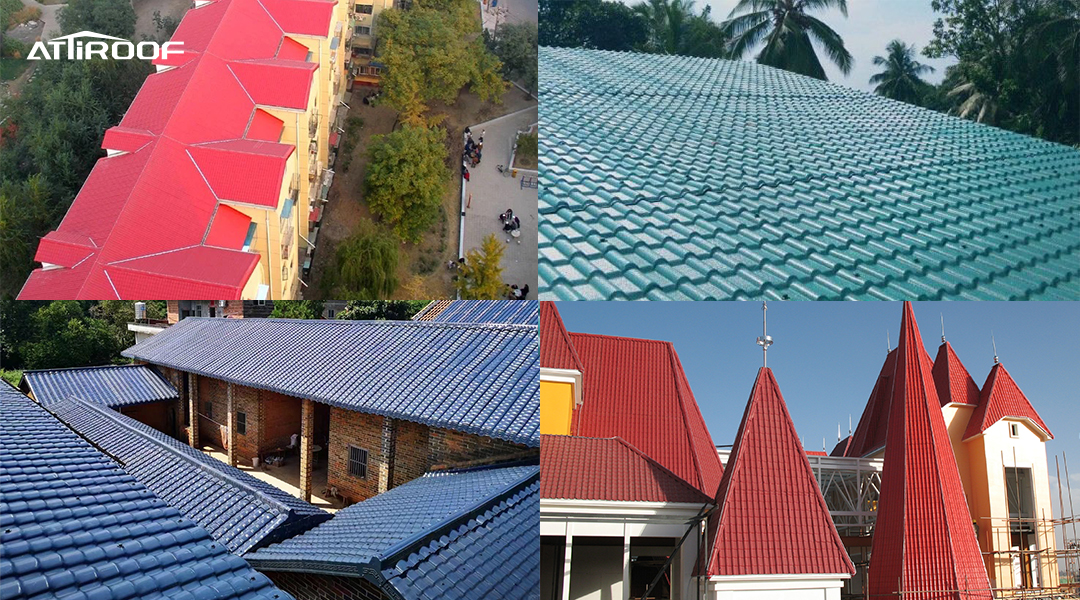
Selecting the right synthetic resin tiles requires a thoughtful consideration of your home's architectural style. Each style has its unique character, and the choice of roofing can significantly enhance its overall appeal.
●Traditional Homes
Owners of traditional homes, such as those with Victorian or Colonial architecture, often seek to preserve the historical charm. Synthetic resin tiles that emulate the appearance of natural slate or classic clay tiles are ideal. They offer the timeless look of these materials while providing improved durability and lower maintenance. Their authentic textures and colors can maintain the heritage aesthetic while offering modern benefits.
●Modern and Contemporary Designs
For homes with modern or contemporary architecture, characterized by sleek lines and minimalist design, the roof should complement this simplicity. Flat-profile synthetic resin tiles in neutral or monochromatic tones work well. They provide a clean, uncluttered look that aligns with the modern ethos, enhancing the architectural integrity with a smooth, uniform finish.
●Cottage and Rustic Styles
Cottage-style or rustic homes, which often feature natural materials and cozy aesthetics, require roofing that adds to their quaint charm. Synthetic resin tiles that mimic wood shakes or shingles are perfect for these homes. They replicate the rustic look of wood but eliminate concerns like rotting, splitting, or frequent maintenance. These tiles can contribute to the warm, inviting feel of a cottage while ensuring long-term performance.
●Mediterranean and Spanish Architecture
For those with homes reflecting Mediterranean or Spanish influences, the roof is a defining feature. Terracotta-style synthetic resin tiles capture the essence of this architectural style. Their curved shape and rich, earthy tones mirror traditional terracotta tiles, making them suitable for adding character and authenticity to these homes. Additionally, their resilience against sun exposure aligns well with the typically sunny climates of Mediterranean-style homes.
●Roof Pitch Considerations
The pitch of the roof also influences tile choice. Steep pitches, common in many traditional and Victorian homes, are well-suited to synthetic resin tiles that offer efficient water shedding and a classic profile. For lower-pitched roofs, often seen in modern designs, choosing tiles with a flatter profile ensures both aesthetic coherence and effective performance.
By considering these aspects, homeowners can align their choice of synthetic resin tiles with the architectural narrative of their homes, ensuring a roof that not only looks aesthetically pleasing but also complements the structural design and period character.
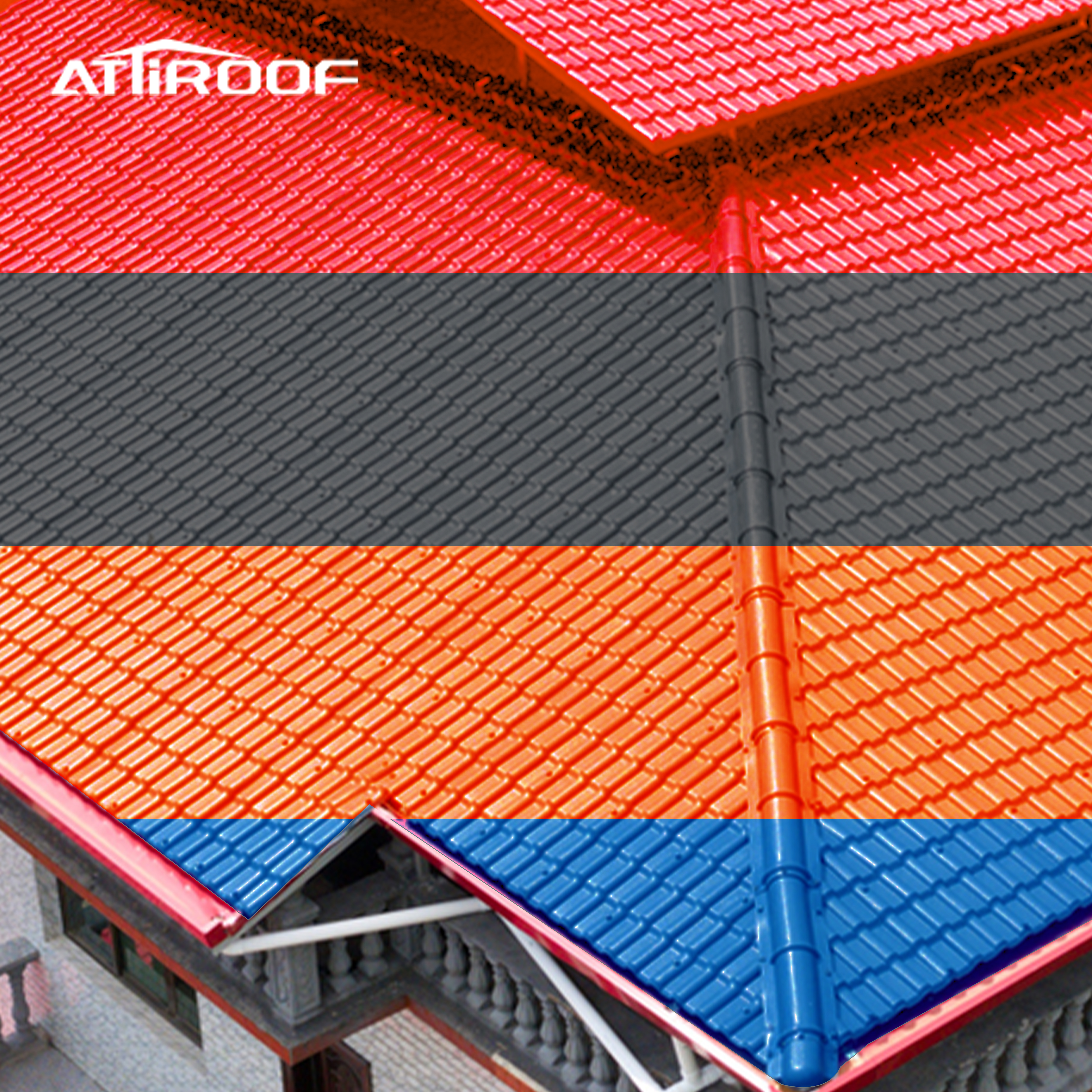
Choosing the right color and texture for your synthetic resin roof tiles is essential in achieving the desired aesthetic for your home. These elements play a significant role in the overall visual appeal and can greatly impact the appearance and character of your property.
●Color Harmony
The color of your roof should complement the overall color scheme of your home’s exterior. For homes with a neutral color palette, you might consider roof tiles in shades of gray, brown, or black to add a sophisticated touch. For more vibrant exteriors, choose tiles in colors that either contrast beautifully or harmonize with the existing colors.
●Architectural Style and Color
The architectural style of your home can also guide your color choice. Classic styles like Colonial or Craftsman may call for more traditional colors like deep reds or earthy browns, while contemporary homes might look best with sleek, darker shades or even bold, unconventional colors.
●Texture for Added Depth
The texture of the tiles contributes to the roof's overall look. A smooth, flat tile can lend a sleek, modern feel, while tiles with a rough or ridged texture can provide a more rustic or traditional appearance. The choice of texture should align with the architectural style of the home and your personal preference.
●Sunlight and Color Perception
Consider how sunlight interacts with your roof. In bright sunlight, some colors might appear lighter or show different hues. It’s advisable to view tile samples in natural light at different times of the day to ensure you’re satisfied with the color in all conditions.
●Long-term Aesthetics
Lastly, think about the long-term appeal of your chosen color and texture. Trends come and go, but your roof will be in place for decades. Select a color and texture that you will be content with for years to come, and that will maintain its appeal should you decide to sell your home in the future.
The right color and texture for your synthetic resin tiles can significantly enhance your home's curb appeal and reflect your personal style. It’s a decision that combines aesthetic preferences with practical considerations, culminating in a roof that’s both beautiful and enduring.
Installing synthetic resin tiles is a critical step in ensuring the longevity and effectiveness of your roofing. Proper installation not only enhances the aesthetic appeal of your home but also ensures durability and optimal performance.
This guide aims to equip you with essential knowledge about installing synthetic resin tiles, covering everything from assessing roof structure compatibility to safety precautions, helping you make informed decisions for a successful installation.
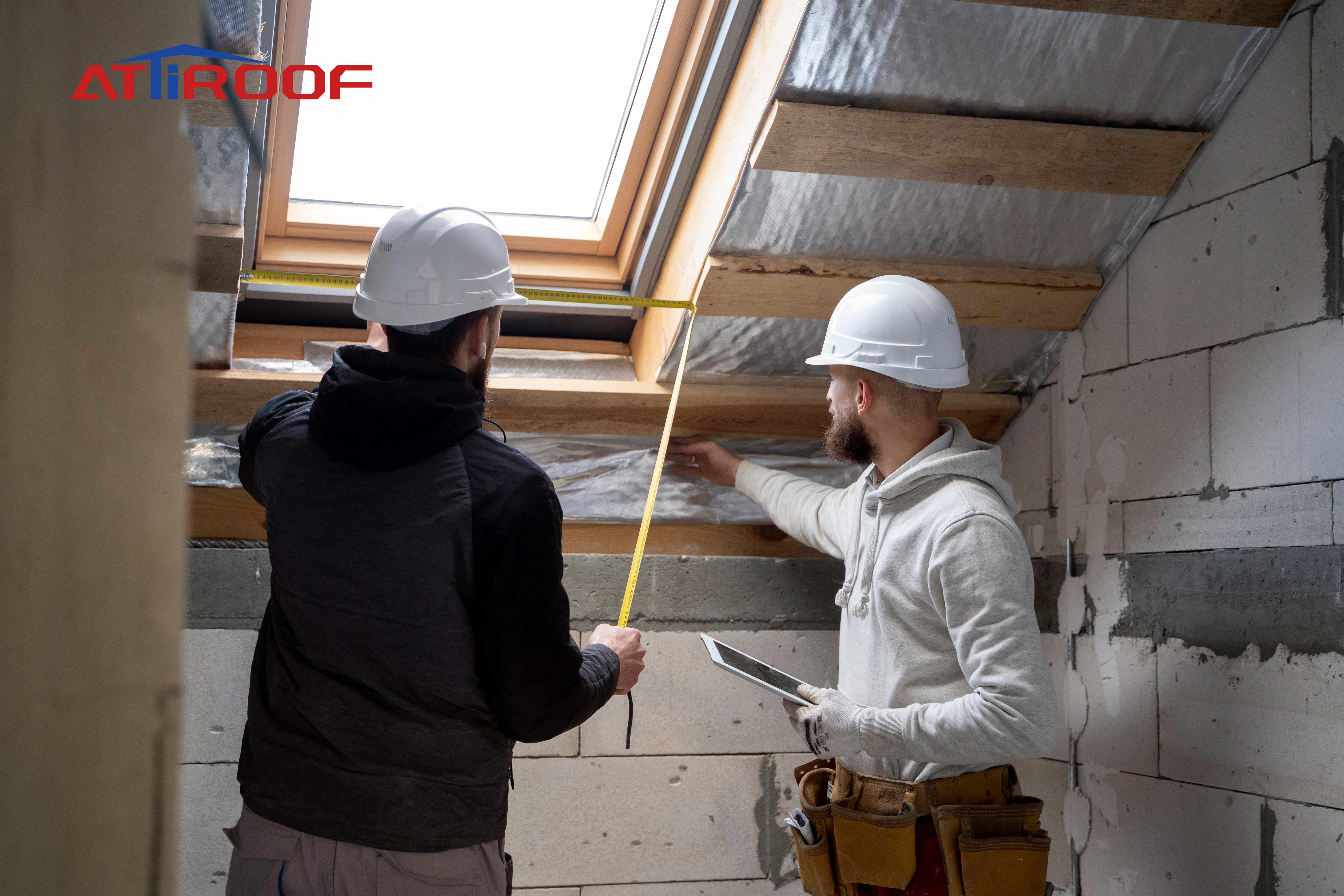
Before proceeding with the installation of synthetic resin tiles, it's crucial to assess the compatibility of your roof structure. This assessment is key to ensuring that your roof can support the tiles and that the installation will be structurally sound.
1. Load Bearing Capacity
Evaluate the load-bearing capacity of your roof structure. Although synthetic resin tiles are relatively lightweight, ensuring that your roof can support their weight, along with any additional underlayment or insulation, is essential.
2. Roof Slope Analysis
The slope of your roof plays a critical role in determining the suitability of synthetic resin tiles. These tiles are versatile and can be installed on a variety of slopes, but it’s important to confirm that the slope of your roof aligns with the manufacturer’s recommendations for optimal water drainage and aesthetic appearance.
3. Underlying Structure Inspection
Examine the condition of the existing roof deck, rafters, and trusses. Any signs of damage, rot, or instability should be addressed before installation. The integrity of these elements is crucial for the long-term performance of your new roof.
4. Ventilation Assessment
Proper ventilation is vital for maintaining the health of your roof. Ensure that your current ventilation system is adequate and meets the requirements for synthetic resin tile roofing. Adequate ventilation helps regulate temperature and moisture levels in the attic, preventing issues like mold growth and heat buildup.
5. Compatibility with Existing Roofing Elements
Check for compatibility with existing roofing elements such as gutters, flashings, and roof penetrations. These components need to integrate seamlessly with the synthetic resin tiles for effective water management and aesthetic coherence.
Assessing your roof’s structure for compatibility with synthetic resin tiles is a fundamental step in the installation process. It ensures that your roof is prepared to provide a stable and lasting foundation for your new tiles, ultimately contributing to the overall success and longevity of your roofing system.
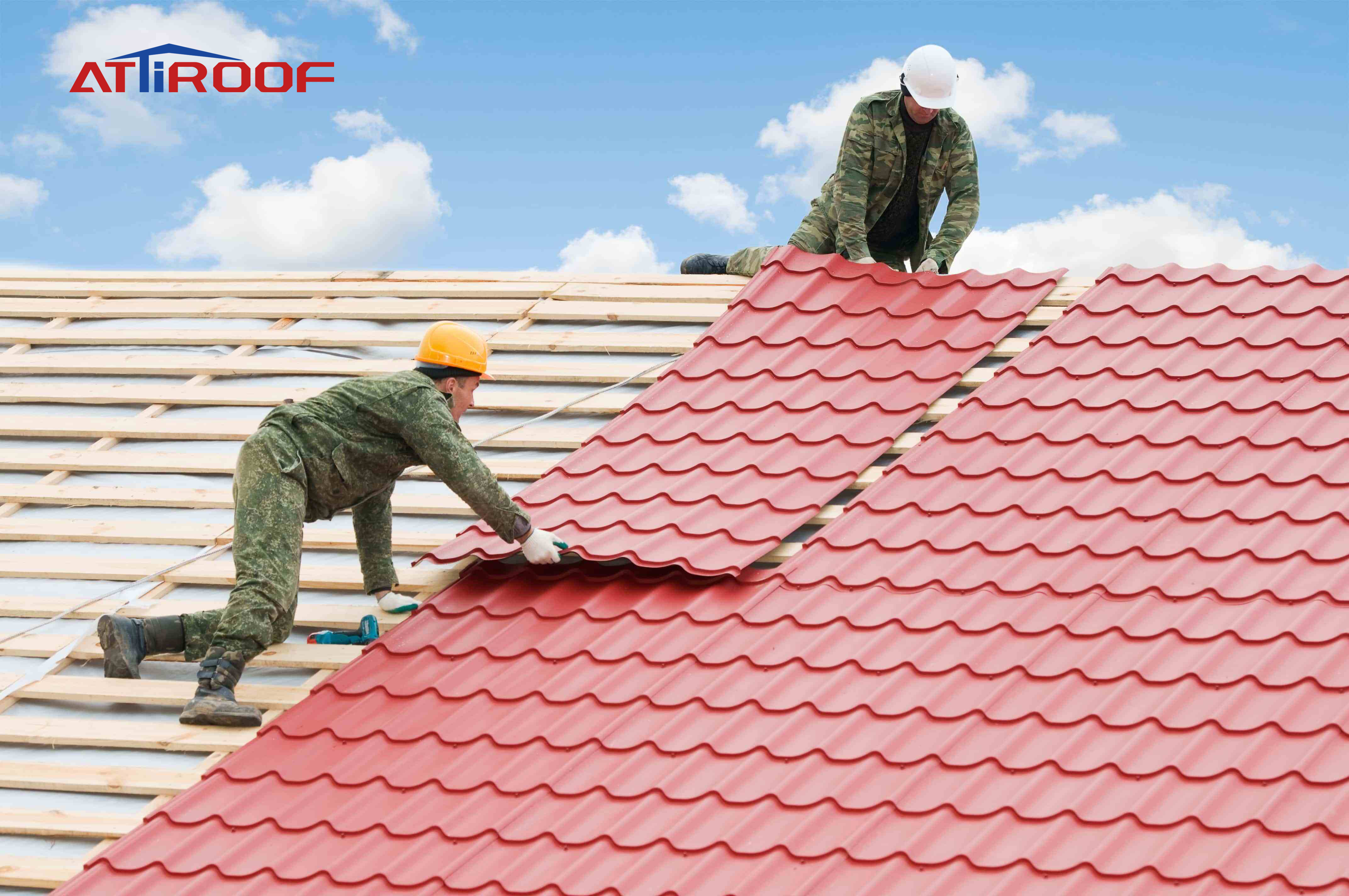
When it comes to installing synthetic resin tiles, homeowners often face the decision between hiring a professional or undertaking a DIY project. Both options have their merits and challenges, and the choice largely depends on individual skill level, experience, and the complexity of the roofing project.
1. Professional Installation:
●Expertise and Efficiency: Professional roofers bring expertise, experience, and specialized tools. They are well-versed in handling the nuances of installation, ensuring that the roofing is installed correctly and efficiently.
●Warranty and Reliability: Many manufacturers offer warranties that are contingent on professional installation. Hiring a professional can ensure that these warranties remain valid.
●Safety: Roofing is inherently risky. Professional installers are trained to work safely at heights and have the necessary safety equipment.
●Time-Saving: A professional team can complete the installation faster than a DIY approach, which can be crucial if the project is time-sensitive.
2. DIY Installation:
●Cost Savings: The primary advantage of DIY installation is the potential cost savings. By eliminating labor costs, the overall expense of the project can be reduced.
●Personal Satisfaction: For those who are skilled and enjoy hands-on work, DIY roofing can be a fulfilling project.
●Flexibility: DIY allows homeowners to work at their own pace and on their own schedule.
●Challenges and Risks: Without the proper skills and tools, DIY installation can be challenging. The risks include potential installation errors and personal safety hazards. Mistakes in installation can lead to long-term issues and additional costs.
Before deciding, consider the complexity of your roof design, your comfort level with construction projects, and the potential risks involved. For many, the benefits of professional installation – expertise, safety, and warranty protection – outweigh the savings of a DIY approach. However, for those with experience in roofing and the necessary tools, DIY can be a viable option.
The installation of synthetic resin tiles, whether done professionally or as a DIY project, requires careful attention to detail. Avoiding common mistakes is crucial to ensure the longevity and effectiveness of your roofing. Here are key pitfalls to steer clear of:
●Inadequate Planning: Lack of proper planning is one of the primary pitfalls. This includes failing to accurately measure the roof area, not ordering the correct quantity of materials, or overlooking necessary accessories like ridge caps, eaves, or gutters. Ensure thorough planning and measurement before beginning the installation.
●Ignoring Manufacturer’s Guidelines: Every brand of synthetic resin tiles may have specific installation guidelines. Ignoring these can lead to improper installation, reducing the effectiveness and lifespan of the tiles. Always adhere to the manufacturer's instructions.
●Poor Underlayment Installation: The underlayment is a critical component of roofing that provides an additional barrier against water. Incorrect installation of the underlayment, or using substandard materials, can lead to leaks and water damage.
●Incorrect Tile Overlapping: Synthetic resin tiles need to be overlapped in a particular manner to ensure effective water runoff. Incorrect overlapping can lead to leaks. Pay attention to the overlap specifications provided by the manufacturer.
●Improper Nailing Technique: Using the wrong nails or nailing technique can cause issues. Nails should be of appropriate length and material, and they should be driven in at the correct angle and depth. Over or under-driving nails can compromise the tile's hold and the roof's integrity.
●Neglecting Ventilation: Adequate roof ventilation is essential to prevent moisture buildup and regulate temperature. Neglecting this aspect during installation can lead to increased energy costs and potential moisture-related issues.
●Failing to Consider Expansion and Contraction: Synthetic resin tiles, like all materials, expand and contract with temperature changes. Not accounting for this can lead to buckling or gaps. Ensure there is adequate space for expansion.
By being mindful of these common mistakes and adhering to best practices, you can ensure a successful installation of your synthetic resin tiles, securing a roof that is not only visually appealing but also durable and functional.
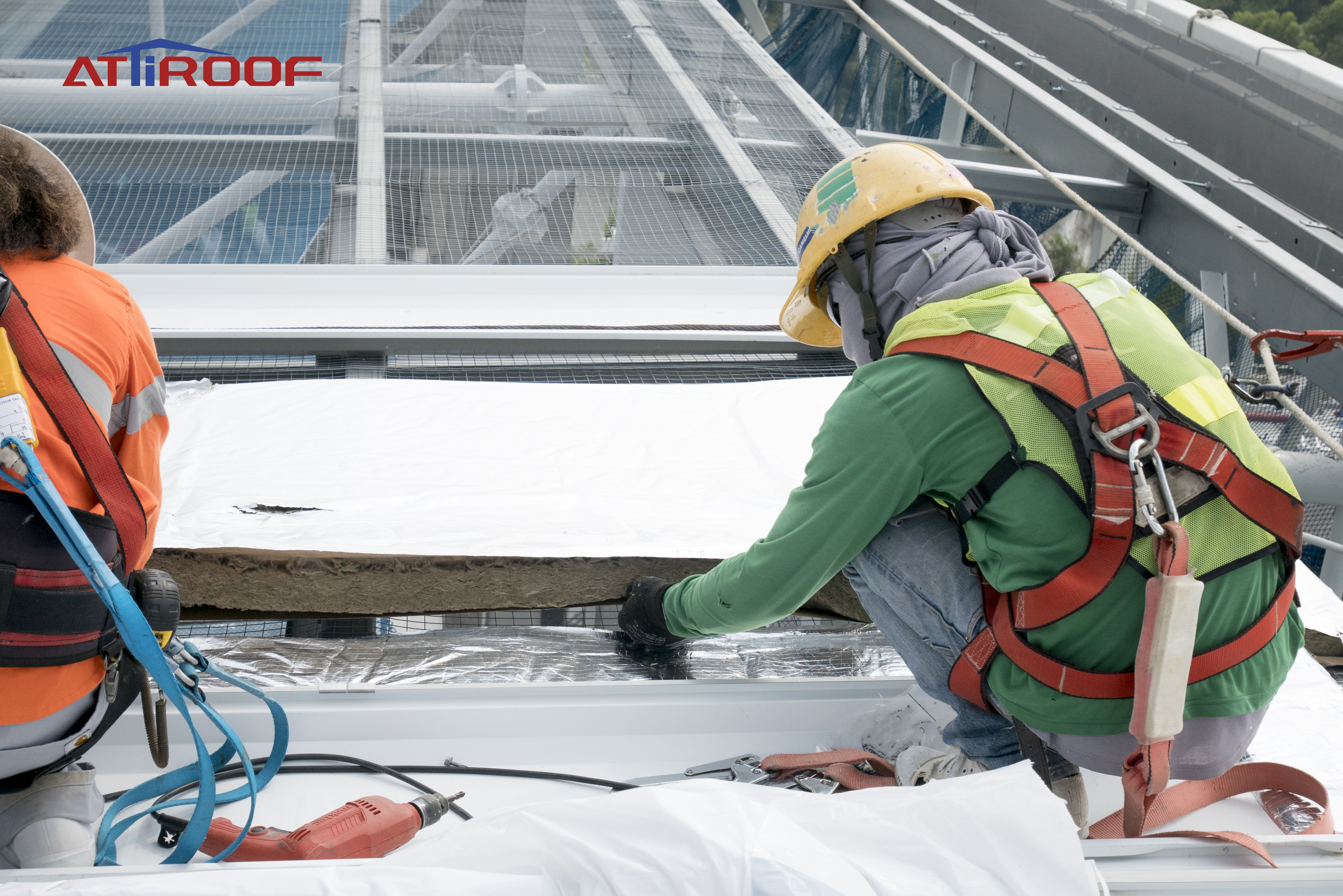
Safety should always be the top priority during the installation of synthetic resin tiles. Whether you're a professional roofer or a homeowner engaging in a DIY project, adhering to safety guidelines is crucial to prevent accidents and ensure a smooth installation process.
●Use of Proper Safety Gear: Always wear appropriate safety gear, including a hard hat, safety glasses, gloves, and non-slip footwear. When working at heights, use a safety harness and ensure it is properly secured.
●Ladder Safety: Ensure that ladders are stable and securely placed. They should extend at least three feet above the edge of the roof for safe and easy access. Never overreach while on a ladder; it's safer to move the ladder frequently.
●Awareness of Roof Edge: Always be aware of your proximity to the roof edge. Falls are a leading cause of injury in roofing jobs. Establish a safe distance from the edge and be constantly mindful of it.
●Proper Tool Handling: Use tools and equipment correctly. Keep them securely fastened in a tool belt or safely stationed on the roof to prevent accidental falls.
●Working in Suitable Weather Conditions: Avoid installing roof tiles in adverse weather conditions. Wet, windy, or excessively hot conditions can increase the risk of accidents. Plan your installation for a day with mild and clear weather.
●Electrical Safety: Be aware of overhead power lines and maintain a safe distance. Also, use caution when handling metal tools or ladders to avoid electrical hazards.
●Training and Assistance: If you are new to roofing, consider getting proper training or assistance from someone experienced. In complex or high-risk situations, it’s advisable to hire professional roofing contractors.
●Keeping the Work Area Clean: A clutter-free work area reduces the risk of trips and falls. Regularly clean up debris, and keep tools and materials organized.
By following these safety precautions, you can significantly reduce the risk of accidents during the installation of synthetic resin tiles. Safety is not just a regulation; it's a commitment to ensuring everyone involved in the project is protected.
A well-maintained roof is key to ensuring the longevity and functionality of your synthetic resin tiles. While these tiles are known for their durability and low maintenance, regular care can further enhance their lifespan and appearance. This section provides essential maintenance tips, helping you keep your synthetic resin roof in top condition throughout the years.
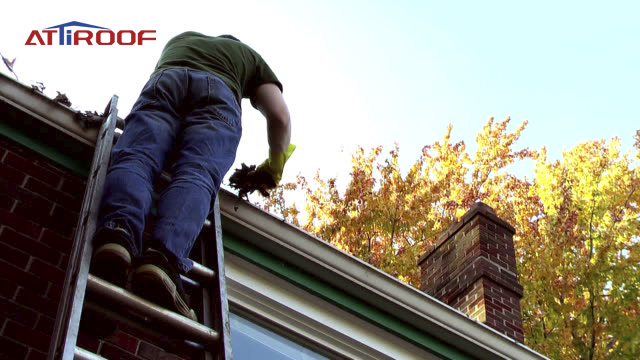
Regular maintenance aligned with the changing seasons can play a pivotal role in preserving the integrity of your synthetic resin roof. Here are some seasonal tips to ensure your roof remains in excellent condition:
●Spring:
1. Inspect for Winter Damage: After the harsh winter months, conduct a thorough inspection of your roof for any signs of damage, such as cracks or loose tiles.
2. Clean Gutters and Downspouts: Clear any debris that has accumulated in your gutters and downspouts to ensure proper drainage during spring rains.
●Summer:
1. UV Protection Check: Inspect for any signs of UV damage or discoloration, especially if your region experiences intense summer sun.
2. Trim Overhanging Tree Branches: Prevent damage from falling branches and minimize debris accumulation by trimming any overhanging tree limbs.
●Autumn:
1. Debris Removal: Fallen leaves, twigs, and other debris can accumulate on your roof. Regular cleaning will prevent the buildup and potential for water pooling.
2. Prepare for Winter: Ensure all tiles are securely fastened and replace any that are damaged to prevent issues from snow and ice.
●Winter:
1. Regular Snow Removal: In areas with heavy snowfall, gently remove snow from the roof to prevent excessive load and ice dam formation.
2. Ice Dam Prevention: Keep an eye out for ice dams along the eaves and take action to prevent their formation.
Each season brings its own set of challenges for roofing maintenance. By following these seasonal maintenance tips, you can proactively address potential issues and ensure that your synthetic resin roof remains a durable, protective, and aesthetic component of your home year-round.
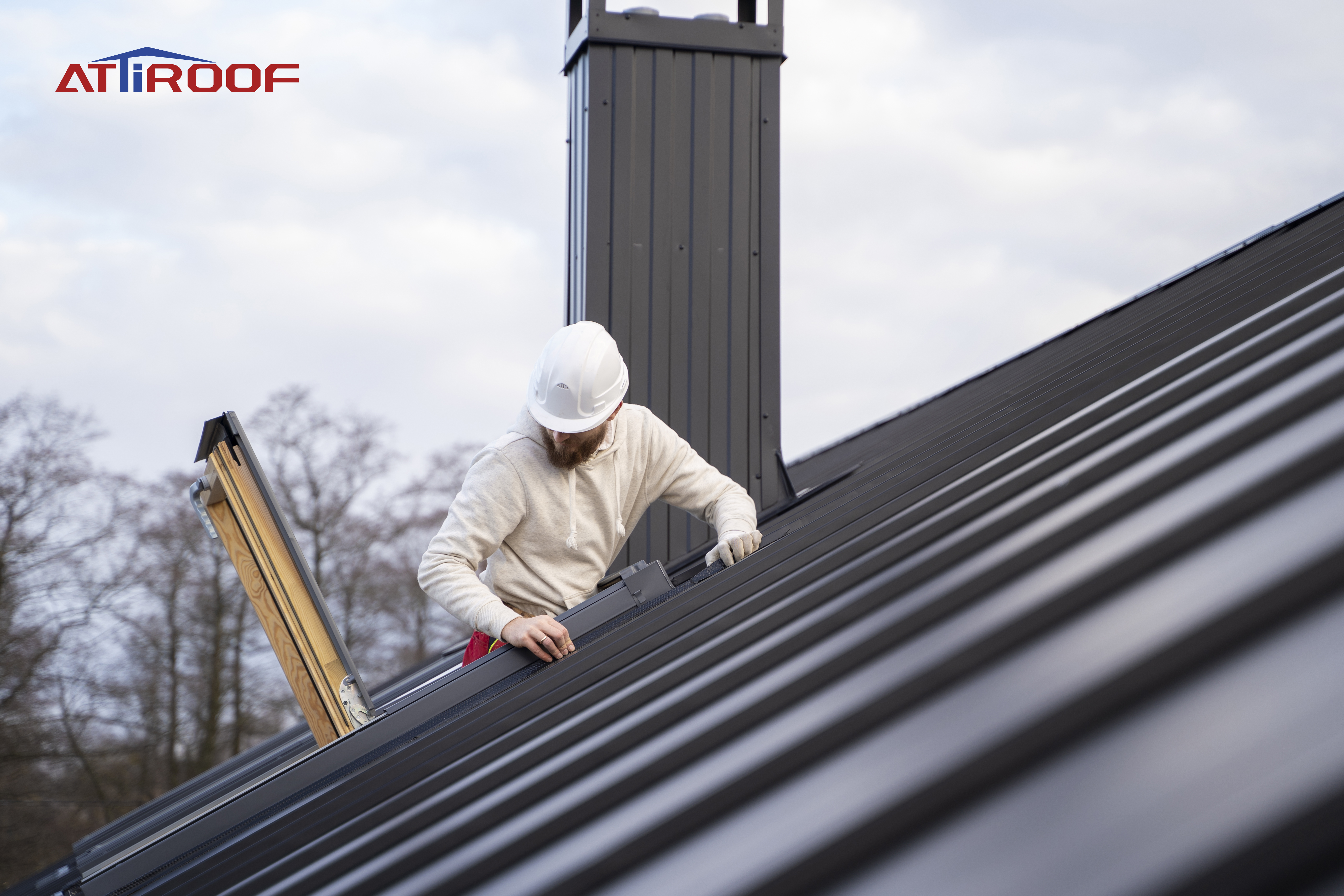
Even the most durable roofing materials like synthetic resin tiles are subject to wear and tear over time. Regularly addressing these common issues can significantly extend the lifespan of your roof and maintain its aesthetic appeal:
●Cracking and Splitting: While synthetic resin tiles are highly resistant to cracking, extreme weather conditions can sometimes cause damage. Inspect for any signs of cracking or splitting, especially after severe weather events. Promptly replace damaged tiles to prevent water infiltration.
●Fading Color: Prolonged exposure to sunlight can lead to some degree of fading over time. While synthetic resin tiles are designed with UV-resistant properties, checking for uneven or significant fading is important. If color restoration is needed, consult with the manufacturer for recommended products or consider professional refinishing services.
●Moss and Algae Growth: In damp, shaded areas, moss and algae can develop on roofing tiles. This doesn’t just affect the roof’s appearance; it can also retain moisture and lead to deterioration. Regular cleaning with a soft brush and appropriate cleaning agents can prevent the buildup of moss and algae. Ensure that trees around the house are trimmed to reduce shade on the roof.
●Debris Accumulation: Fallen leaves, twigs, and other debris can accumulate on the roof and in gutters, leading to water pooling and potential damage. Regular cleaning of the roof and gutters, especially after storms or during the autumn season, is crucial for maintaining good roof health.
●Loose or Misaligned Tiles: Over time, tiles may become loose or misaligned. This can be due to natural settling of the house, improper installation, or severe weather. Regularly check the alignment of the tiles and secure any that are loose to ensure proper roof integrity.
●Sealant and Flashing Check: Periodically inspect the sealant and flashing around vents, chimneys, and skylights. Cracked or peeling sealant and damaged flashing can lead to leaks. Replace or repair these as necessary to maintain a watertight roof.
By routinely addressing these common wear and tear issues, you can prevent minor problems from turning into major repairs, ensuring that your synthetic resin roof continues to provide reliable protection and retains its aesthetic qualities for many years.
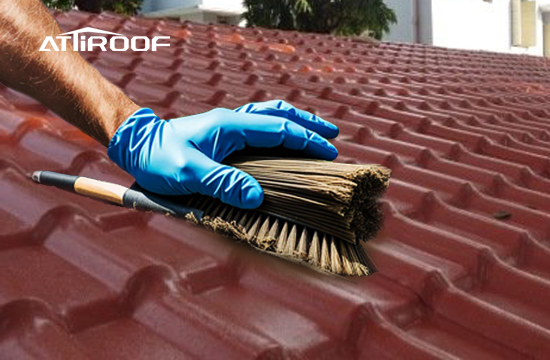
Maintaining the longevity and aesthetic appeal of your synthetic resin roof involves more than just addressing immediate repairs and seasonal challenges. Adopting best practices for long-term care and upkeep is crucial in ensuring that your roof remains in optimal condition for years to come. Here are key strategies for maintaining the long-term health of your synthetic resin roof:
●Regular Inspections: Conduct bi-annual inspections of your roof, preferably in the spring and fall. Look for signs of wear and tear, and address any issues promptly. Pay special attention to areas around protrusions like vents and chimneys, as these are common spots for leaks.
●Gentle Cleaning: To preserve the appearance and integrity of the tiles, clean your roof gently using a low-pressure washer or a soft brush with a mild cleaning solution. This will remove dirt, grime, and any biological growth without damaging the tiles.
●Immediate Repairs: If you notice any damage, such as loose or cracked tiles, address it immediately. Small issues can quickly escalate into larger problems if left unattended.
●Gutter Maintenance: Keep gutters and downspouts clear of debris. Clogged gutters can cause water to back up and damage your roof. Regular cleaning will ensure proper water flow away from the roof.
●Trim Overhanging Branches: Overhanging branches can scratch and damage tiles during high winds, and falling leaves can clog gutters. Keep trees trimmed to minimize these risks.
●Avoid Walking on the Roof: Walking on your roof can lead to accidental damage to the tiles. If roof access is necessary, use walk pads or boards to distribute weight evenly.
●Professional Check-ups: Even if you’re diligent with maintenance, it’s beneficial to have a professional roofing contractor inspect your roof every few years. They can identify potential issues that you might miss and provide expert maintenance advice.
By adhering to these best practices for care and upkeep, you’ll ensure that your synthetic resin roof continues to provide beauty and protection to your home. Regular maintenance is key to avoiding costly repairs down the line and keeping your roof looking and performing its best for as long as possible.
Even with meticulous maintenance, emergencies can arise that require immediate attention to prevent further damage to your synthetic resin roof. Knowing how to handle these situations effectively is crucial. Here are some essential tips for emergency repairs:
1. Identify the Source of the Problem
In case of a leak, the first step is to identify its source. Check for broken or displaced tiles, cracks, or holes. Remember that water can travel from the original entry point, so the area needing repair might not be directly above the leak.
2. Temporary Leak Patching
For a quick fix to a leaking roof, use a high-quality roof sealant or patching tape designed for synthetic resin materials. Apply it to the cleaned, dry area around the leak. This is a temporary solution until a more permanent repair can be made.
3. Securing Loose Tiles
If tiles have become loose, reattach them temporarily with roofing adhesive or nails. Ensure the fix is secure enough to prevent further movement or damage.
4. Removing Debris
If the emergency is caused by debris, such as after a storm, carefully remove any branches or objects that are on the roof. Be sure to wear appropriate safety gear and take necessary precautions to avoid causing further damage to the tiles.
5. Professional Assessment
After addressing the immediate issue, it's advisable to contact a roofing professional for a thorough assessment. They can provide a more permanent solution and check for any underlying issues that might have led to the emergency.
6. Document the Damage
If the damage is extensive, take photos for insurance purposes. Documenting the damage can help with any insurance claims or professional evaluations.
7. Preventative Measures
Once repairs are completed, consider taking steps to prevent future emergencies, such as regular inspections and maintenance.
Remember, safety is paramount. If the damage is extensive or if accessing your roof is risky, it's best to call in professionals. Emergency repairs are a stopgap measure to mitigate immediate damage and should be followed up with professional assessment and repair.
In today's environmentally conscious world, the impact of building materials on our planet is scrutinized more than ever. Synthetic resin roof tiles, known for their durability and aesthetic appeal, also carry an environmental footprint worth exploring. This section delves into the various environmental aspects of synthetic resin roof tiles, including their production carbon footprint, disposal and recycling options, and compliance with green building standards, providing a comprehensive understanding of their ecological impact.
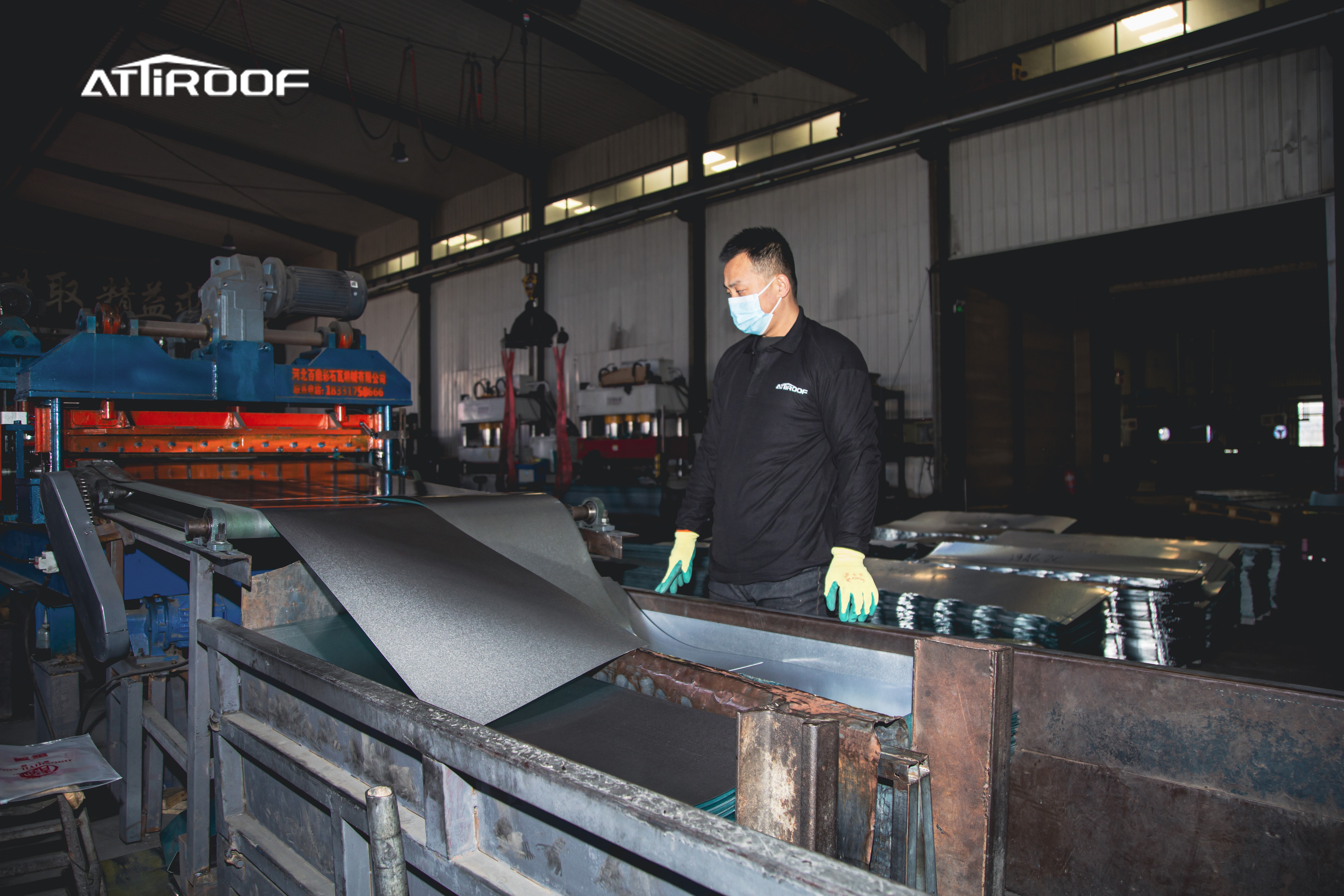
Evaluating the environmental impact of synthetic resin roof tiles requires a detailed look at their production carbon footprint, supported by data and industry studies:
●Energy Efficiency in Manufacturing: According to industry reports, modern manufacturing processes for synthetic resin tiles have become increasingly energy-efficient. For example, a study by the Building Materials Institute indicates that the energy required to produce one square meter of synthetic resin tile has decreased by approximately 20% over the past decade, due to improved manufacturing technologies.
●Reduced Resource Consumption: Comparative analyses show that synthetic resin tiles require significantly less raw material extraction than traditional roofing materials. The International Journal of Environmental Research notes that the production of synthetic resin tiles uses about 30% less natural resources compared to traditional clay tiles.
●Emission Controls: Manufacturing plants for synthetic resin tiles are increasingly adopting emission control technologies. Data from the Environmental Protection Agency (EPA) suggest that the implementation of scrubbers and filters has led to a reduction of over 40% in VOC emissions in the last five years from these facilities.
●Transportation Impact: A logistics study highlighted that synthetic resin tiles, being lightweight, reduce the carbon emissions associated with transportation by up to 25% compared to heavier roofing materials like slate or concrete tiles.
●Lifecycle Carbon Footprint: Lifecycle assessment reports indicate that synthetic resin tiles have a lower overall carbon footprint when considering their long lifespan and minimal maintenance requirements. The Global Building Materials Council states that over a 30-year period, synthetic resin roofs can have a carbon footprint that is approximately 35% lower than traditional roofing materials.
These data points and research findings illustrate that while the production of synthetic resin tiles does involve some environmental impact, ongoing improvements in manufacturing efficiency, resource use, and emission controls are contributing to a significant reduction in their overall carbon footprint. This makes them a more sustainable option in the roofing materials market.
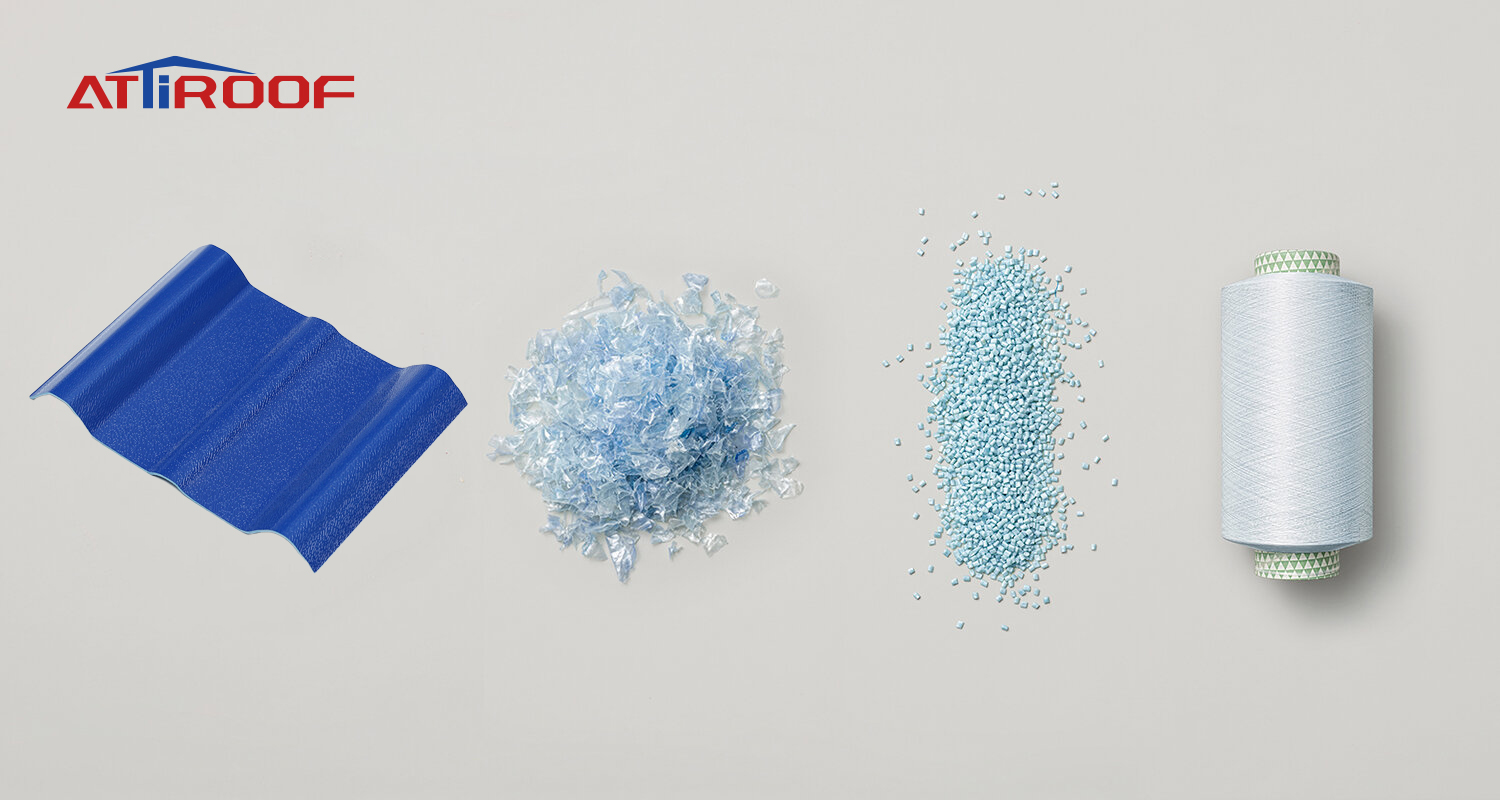
The environmental responsibility of any building material is not just defined by its performance during use but also by how it is disposed of or recycled at the end of its life. Synthetic resin roof tiles, with their unique composition, present several environmentally friendly options at the end of their lifecycle:
●Recyclability: One of the key environmental benefits of synthetic resin tiles is their recyclability. Made from polymers like PVC or other plastics, these tiles can be ground down and repurposed into new roofing materials or other plastic products. This process significantly reduces the waste sent to landfills and conserves resources by reusing the base materials.
●Energy Recovery: In some cases, the energy content of non-recyclable portions of synthetic resin tiles can be recovered. They can be used as a fuel source in industrial processes, thus contributing to energy generation and reducing the consumption of fossil fuels.
●Reduced Landfill Impact: Because synthetic resin tiles are durable and have a long lifespan, they contribute less frequently to landfill waste compared to some traditional roofing materials that may require more frequent replacement.
●Innovative Recycling Programs: Many manufacturers and environmental organizations are working on innovative recycling programs specifically for synthetic resin materials. These initiatives aim to streamline the process of collecting, processing, and repurposing old synthetic resin tiles, making the recycling process more efficient and accessible.
●Design for Disassembly: Modern advances in manufacturing include the concept of 'design for disassembly,’ where synthetic resin tiles are designed in a way that they can be easily separated and recycled at the end of their useful life. This approach not only facilitates recycling but also aligns with the principles of sustainable design.
The end-of-life disposal and recycling options for synthetic resin roof tiles reflect a commitment to environmental sustainability. By offering viable recycling and energy recovery options, these tiles help reduce the environmental impact associated with roofing materials, contributing to a more sustainable building industry.
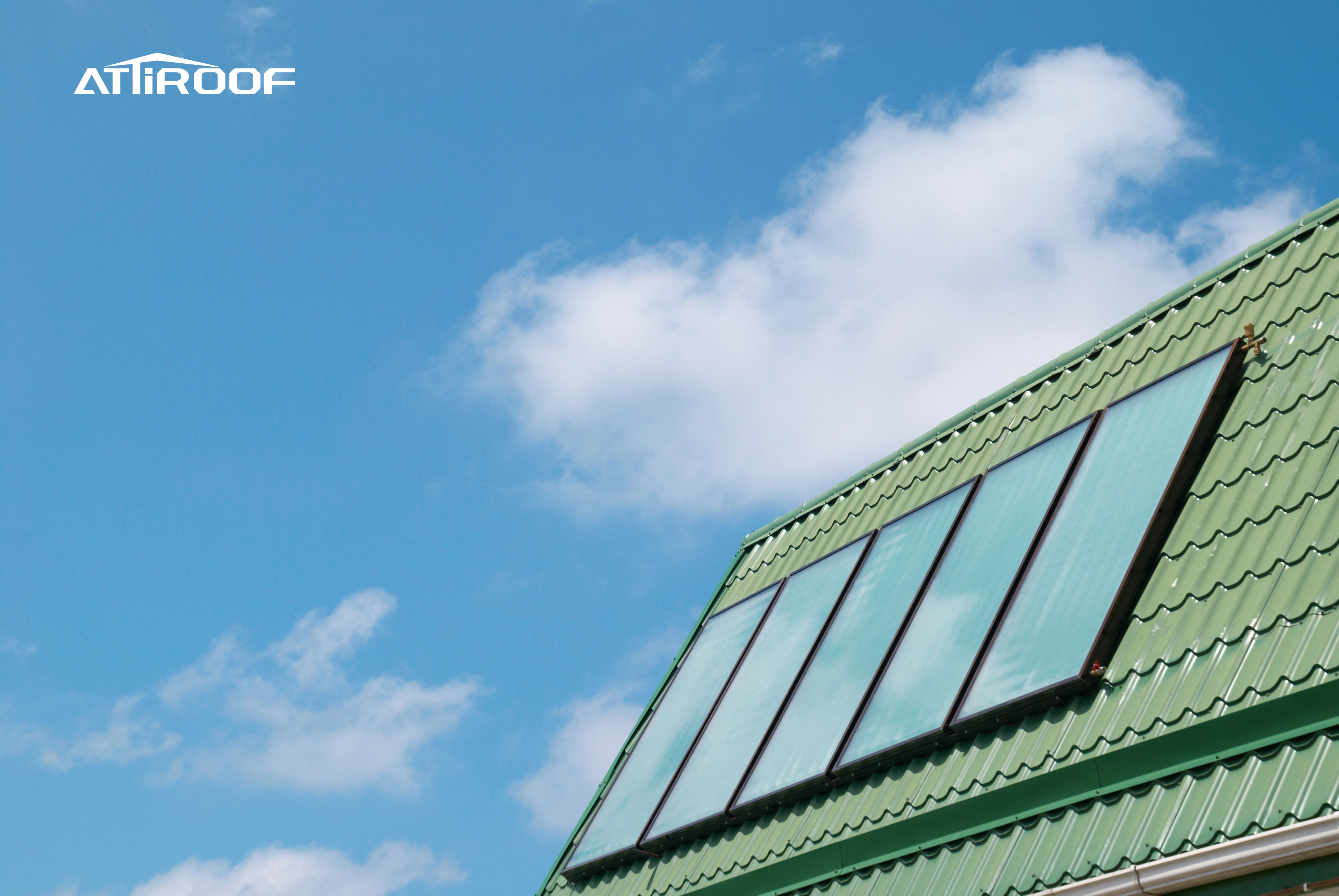
In the realm of sustainable construction, compliance with green building standards is paramount. Synthetic resin roof tiles are increasingly recognized for their alignment with these standards, contributing to the construction of environmentally responsible and resource-efficient buildings.
●Energy Efficiency: Synthetic resin tiles often meet and exceed the criteria for energy-efficient building materials. Their reflective properties contribute to reducing heat absorption, thereby lowering energy costs and reducing the overall environmental impact of buildings. This aligns with standards such as LEED (Leadership in Energy and Environmental Design) and BREEAM (Building Research Establishment Environmental Assessment Method), which emphasize energy efficiency.
●Resource Conservation: The manufacturing of synthetic resin tiles involves the use of recycled materials, reducing the demand for virgin resources. This process of utilizing post-consumer or post-industrial recycled content supports resource conservation, a key aspect of green building certifications.
●Indoor Environmental Quality: These tiles contribute to healthier indoor environments by being low in VOC (Volatile Organic Compounds) emissions. This is crucial for certifications like LEED, which assess the impact of building materials on indoor air quality.
●Durability and Lifecycle Impact: The longevity of synthetic resin tiles means less frequent replacement and reduced resource usage over time. Their durability is a significant factor in green building standards, which consider the lifecycle impact of construction materials.
●Innovation in Design: Many green building certifications reward innovative practices. The use of synthetic resin tiles, particularly those designed for disassembly and recycling, can contribute to innovation credits, as they represent an advancement in sustainable roofing technologies.
Compliance with green building standards is not just about meeting regulatory requirements; it's about contributing to the global movement towards more sustainable construction practices. Synthetic resin roof tiles, with their energy-efficient, resource-conserving, and low-emission characteristics, play an integral role in this movement, helping builders and architects create buildings that are as environmentally responsible as they are functional and aesthetically pleasing.
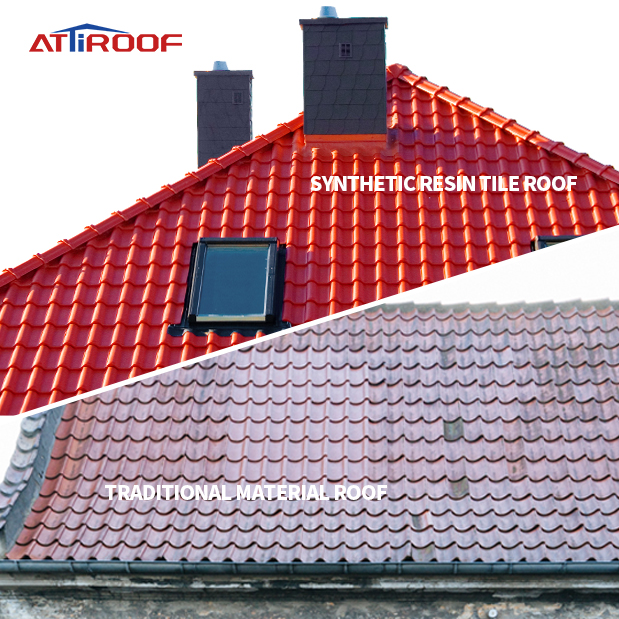
When it comes to roofing, the decision often boils down to a balance between initial costs and long-term value. Synthetic resin tiles, known for their durability and aesthetic appeal, are an investment in the future of your property. This section explores the economic viability of synthetic resin tiles, comparing their upfront costs to traditional materials, analyzing their return on investment over time, and examining potential financial incentives that can make them an even more attractive option.
From an investment standpoint, it's essential to dissect the initial expenses involved in opting for synthetic resin tiles compared to traditional roofing materials:
1. Material Costs Comparison:
●Asphalt Shingles: Often seen as the most cost-effective option, asphalt shingles have lower initial material costs. However, for investors, it's crucial to consider their shorter lifespan and higher replacement frequency.
●Natural Slate or Clay Tiles: While these materials offer a premium look, their costs can be significantly higher than synthetic resin tiles. They also add considerable weight to the roof structure, which might necessitate additional structural reinforcement, further elevating the total investment.
2. Installation Costs Nuances:
●Labor Efficiency: Synthetic resin tiles are lighter and easier to work with, which can translate into faster installation and lower labor costs. This efficiency is particularly beneficial for projects with tight timelines or for properties in areas with higher labor rates.
●Specialized Skills: Unlike some traditional materials that may require specialized skills for installation, synthetic resin tiles can be installed by a broader range of contractors, potentially reducing the cost of hiring specialized labor.
3. Durability and Lifespan Considerations:
●Long-Term Investment: The extended lifespan of synthetic resin tiles means they may not require replacement for decades, a significant consideration for long-term property investments. This durability translates into cost savings over time, offsetting the higher initial material cost.
●Maintenance Costs: The minimal maintenance required for synthetic resin tiles compared to, say, the frequent resealing needed for asphalt shingles or the potential cracking and chipping in slate or clay tiles, represents ongoing cost savings.
4. Structural Support and Additional Costs:
●Weight Implications: Heavier traditional materials like slate or clay may necessitate structural modifications to support their weight, an additional cost that can impact the overall budget of a roofing project.
●Roof Complexity: For complex roof designs, the ease of cutting and fitting synthetic resin tiles can result in lower installation costs compared to more rigid materials that might require more labor-intensive customization.
In an investor’s assessment, while synthetic resin tiles might present a higher upfront cost than some traditional options, their extended durability, lower maintenance, and potential savings in installation and long-term care position them as a cost-effective solution over the lifespan of the property.
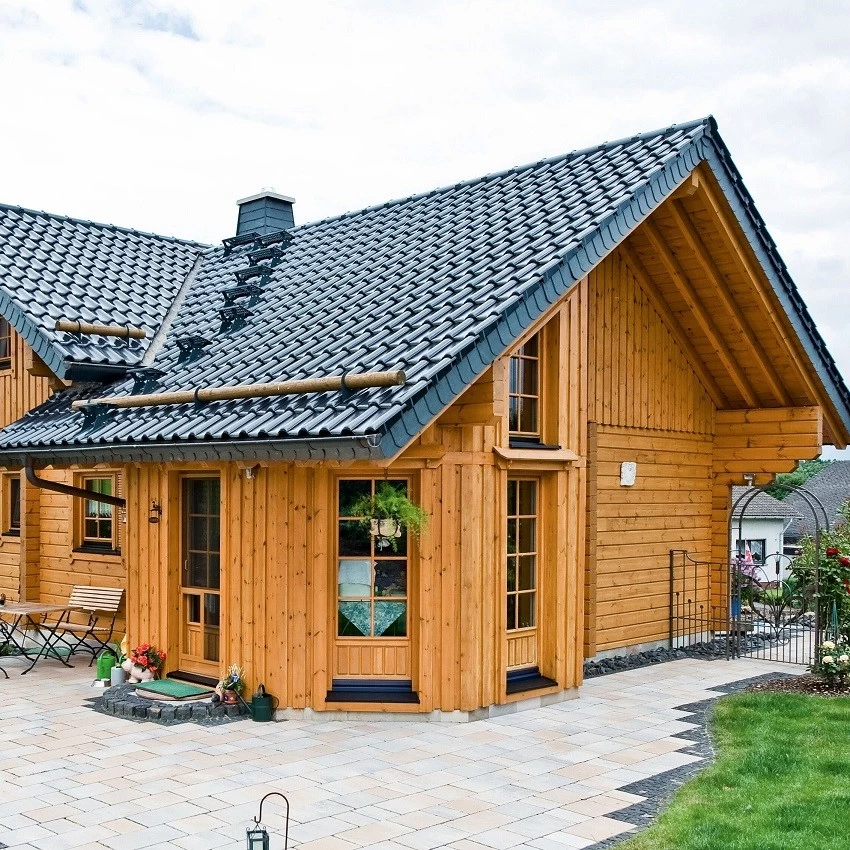
When considering synthetic resin tiles for roofing, analyzing the return on investment (ROI) over time is crucial in determining their economic viability. This long-term perspective is essential for homeowners and investors alike.
●Longevity and Durability: One of the most significant factors contributing to the ROI of synthetic resin tiles is their longevity. These tiles often have a lifespan that can exceed 50 years, far surpassing the durability of traditional materials like asphalt shingles, which may require replacement every 15 to 20 years. This extended lifespan means fewer replacements and, consequently, reduced long-term costs.
●Energy Efficiency Savings: Synthetic resin tiles contribute to energy efficiency with their insulative properties and reflective surfaces. Over time, these features can lead to significant savings on heating and cooling costs. For instance, a study shows that homes with energy-efficient roofing can save up to 15% on annual energy bills.
●Minimal Maintenance Requirements: Unlike some traditional roofing materials that require regular maintenance, synthetic resin tiles are relatively maintenance-free. The cost savings from this reduced need for upkeep further contribute to the ROI, particularly when calculated over several decades.
●Property Value Increase: The aesthetic appeal and durability of synthetic resin tiles can enhance the overall value of a property. Real estate experts suggest that a high-quality, durable roof can increase a home's resale value, offering a return on investment at the time of sale.
●Cost Comparison Over Time: While the initial cost of synthetic resin tiles may be higher than some alternatives, the total expenditure over the life of the roof is often lower. For example, over a 30-year period, the cost of installing and maintaining a synthetic resin roof can be up to 20-30% less than that of traditional roofing materials when factoring in replacement, repairs, and maintenance.
In conclusion, the ROI of synthetic resin tiles becomes increasingly advantageous when viewed over an extended period. Their durability, energy efficiency, low maintenance, and positive impact on property value all contribute to a favorable return on investment, making them a financially sound choice for long-term roofing solutions.
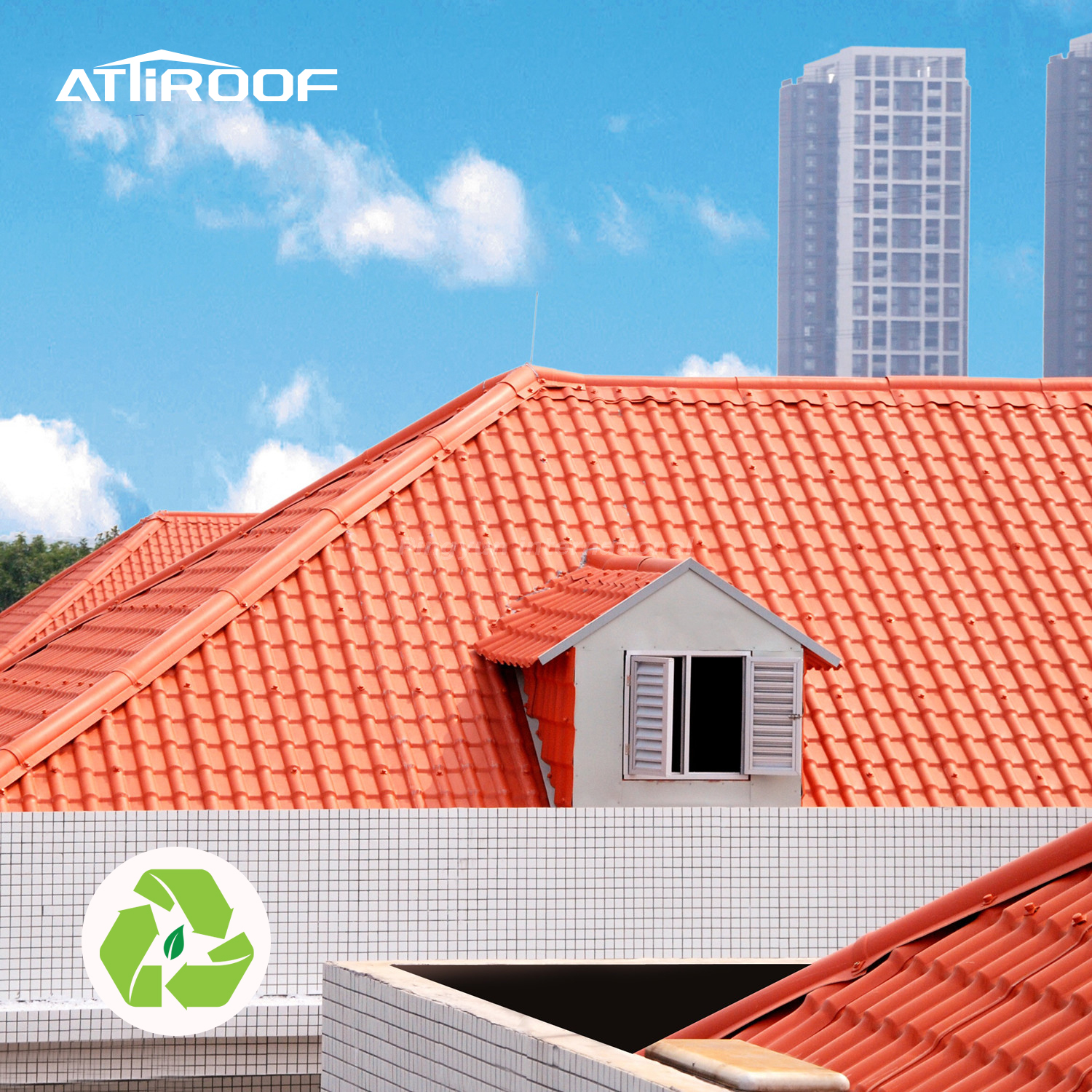
For homeowners and investors considering synthetic resin tiles, various financial incentives can enhance their economic viability. Grants, subsidies, and cost-saving programs often exist to encourage the use of sustainable and energy-efficient building materials:
●Government Incentives for Green Building: Many governments offer incentives for using eco-friendly building materials. This can include tax credits, rebates, or subsidies for installing energy-efficient roofing like synthetic resin tiles. For example, in the United States, homeowners may qualify for tax credits under the Energy Star program when they install roofing materials that meet specific energy efficiency criteria.
●Local Grants and Subsidies: Depending on the location, local governments or councils might provide grants or subsidies for home renovations that improve energy efficiency. These can often be applied to the installation of synthetic resin roof tiles, especially if they contribute to better insulation and lower energy consumption.
●Utility Company Programs: Some utility companies offer cost-saving programs or rebates for homeowners who choose to install energy-efficient roofing. These programs are designed to encourage energy conservation and can help offset the initial cost of installation.
●Green Building Certifications: While not direct financial incentives, certifications like LEED (Leadership in Energy and Environmental Design) can increase the value of a property. Properties with such certifications might attract buyers willing to pay a premium for a home that adheres to green building standards.
●Insurance Discounts: In certain regions, homeowners with energy-efficient and durable roofing materials like synthetic resin tiles can qualify for reduced home insurance premiums. This is due to the decreased risk of damage from environmental factors.
●Manufacturer Rebates and Offers: Some manufacturers of synthetic resin tiles offer rebates, discounts, or special offers as part of promotional campaigns. It’s worth researching and reaching out to manufacturers for any potential cost-saving opportunities.
These grants, subsidies, and programs can significantly reduce the effective cost of synthetic resin tiles, making them a more attractive option financially. Homeowners and investors are encouraged to explore these options to maximize their investment and contribute to sustainable building practices.
The manufacturing of synthetic resin tiles is not just about the here and now; it's a field ripe with innovation and forward-thinking technologies. As we look to the future, these advancements promise to revolutionize the way we think about roofing. This section explores the cutting-edge innovations and emerging trends in synthetic resin tile manufacturing, highlighting how they align with the evolving demands of sustainability, efficiency, and smart home integration.
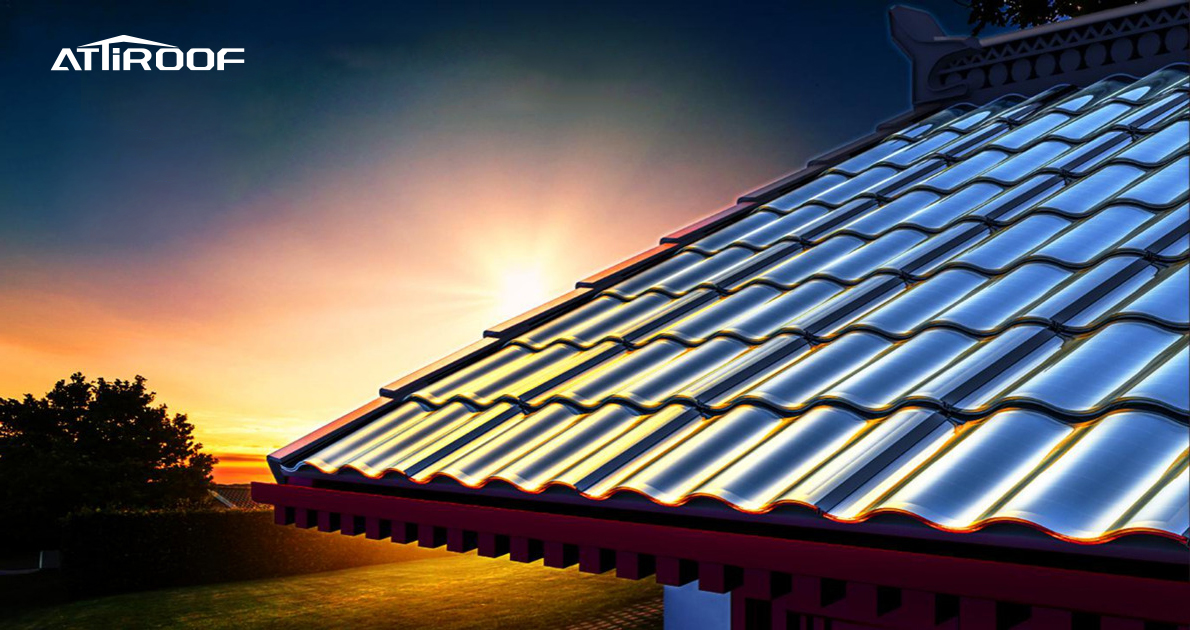
The future of synthetic resin roof tiles is being reshaped by smart technology, making them not just a cover over our heads but a functional part of our homes. Here’s how this technology is being integrated, explained in a more accessible way:
●Solar-Powered Tiles: Imagine tiles that look like regular roof tiles but can generate electricity like solar panels. These are solar-integrated tiles, which allow your roof to produce solar energy without the need for bulky solar panels. For instance, a house with these tiles could generate enough power to run several home appliances, contributing to reduced electricity bills.
●Tiles That Adapt to Weather: Some future tiles may change their properties based on the weather. On hot summer days, they can reflect more sunlight, keeping your house cooler. During winter, they do the opposite by retaining heat. It’s like having a roof that adjusts itself to keep you comfortable in different seasons.
●Self-Cleaning Roof Tiles: Imagine roof tiles that clean themselves. Coated with special materials, these tiles can use sunlight to break down dirt and grime, which then gets washed away by rain. This means less maintenance and a roof that stays looking new for longer.
●Sensors in Tiles: Think of tiles as mini weather stations on your roof. Equipped with sensors, they can monitor conditions like humidity or temperature. This information can be sent to your smartphone, letting you know if there’s something unusual, like a potential leak or a heat loss spot.
●Energy Monitoring Tiles: Future tiles might not only help in generating energy but also in monitoring it. If your roof has solar-integrated tiles, it could track how much energy is being produced and used. This is like having a smart meter right on your roof, helping you understand and manage your home’s energy usage more effectively.
Incorporating smart technology in synthetic resin tiles is like giving your roof a brain and some superpowers. It’s not just about shelter anymore; it’s about making your roof an active, energy-efficient, and intelligent part of your home.
In the era of environmental consciousness, the evolution of eco-friendly materials in the manufacturing of synthetic resin tiles is a significant trend. This progression not only addresses environmental concerns but also caters to the growing demand for sustainable building practices.
●Sustainable Raw Materials: The shift towards using more sustainable raw materials in synthetic resin tile production is notable. Manufacturers are increasingly incorporating recycled plastics and bio-based resins. For instance, some tiles now include recycled polyethylene (PET) from plastic bottles, reducing waste and conserving resources.
●Lower Environmental Impact Production: Innovations in production processes focus on reducing carbon emissions and energy consumption. Advanced manufacturing techniques are being developed to minimize waste and maximize efficiency. For example, some factories are now using solar power or other renewable energy sources to reduce their carbon footprint.
●Non-Toxic Additives: The move towards non-toxic and environmentally friendly additives in the resin composition is gaining momentum. This includes phasing out harmful chemicals and using natural colorants and UV stabilizers, which are safer for both the environment and the people involved in the manufacturing process.
●Biodegradable Options: Research is underway to develop biodegradable synthetic resin materials. These would break down naturally at the end of their lifespan, offering a solution to the issue of roofing waste in landfills.
●Life Cycle Assessment (LCA): Manufacturers are increasingly using LCA to evaluate the environmental impact of their tiles from production to disposal. This comprehensive approach ensures that every stage of the tile's life cycle is as eco-friendly as possible.
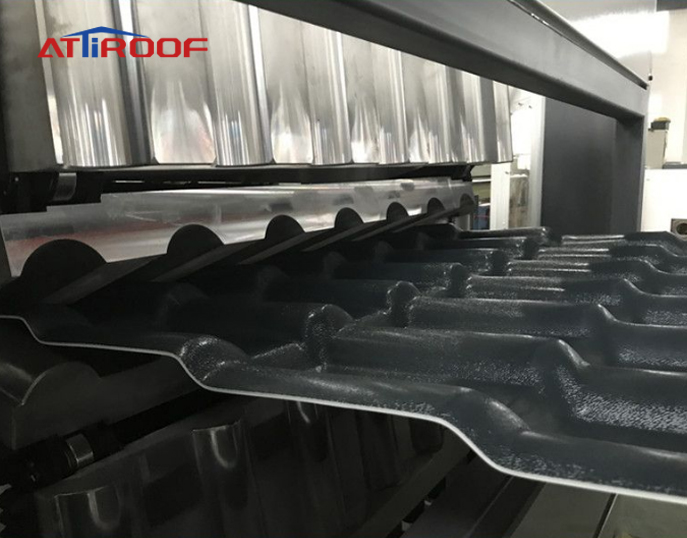
These advancements in eco-friendly materials are a testament to the industry's commitment to sustainability. By adopting greener practices and materials, synthetic resin tile manufacturing is not only reducing its environmental footprint but also paving the way for a more sustainable future in construction.
An in-depth understanding of market trends and consumer demands is pivotal for steering the future of synthetic resin tiles. Here's an analysis backed by authoritative data and reports:
1. Sustainability as a Priority
A recent market analysis by the Global Green Building Council showed a 15% annual growth in demand for eco-friendly building materials. Synthetic resin tiles are gaining popularity, particularly those utilizing recycled content, aligning with this green trend.
2. Durability and Low Maintenance
According to a consumer survey conducted by the National Roofing Contractors Association, over 70% of homeowners prioritize longevity and ease of maintenance when choosing roofing materials. Synthetic resin tiles, known for their long lifespan and minimal upkeep, meet these criteria, making them a preferred choice.
3. Aesthetic Versatility
A study by the American Institute of Architects highlighted that 65% of homeowners showed a preference for customizable aesthetic options in building materials. The ability of synthetic resin tiles to offer various colors and styles, mimicking natural materials, caters to this growing trend.
4. Integration with Smart Home Technology
The Smart Home Market Report 2022 indicated a rising interest in integrating roofing with smart home systems. Innovations in synthetic resin tiles, like embedded solar cells and sensory technology, resonate well with consumers looking to embrace smart, energy-efficient homes.
5. Balancing Affordability and Quality
Market research from the International Building Association revealed that while consumers are willing to invest more upfront for higher quality, the overall cost remains a decisive factor. This necessitates manufacturers to balance affordability with the advanced features of synthetic resin tiles.
6. Climate-Adaptive Solutions
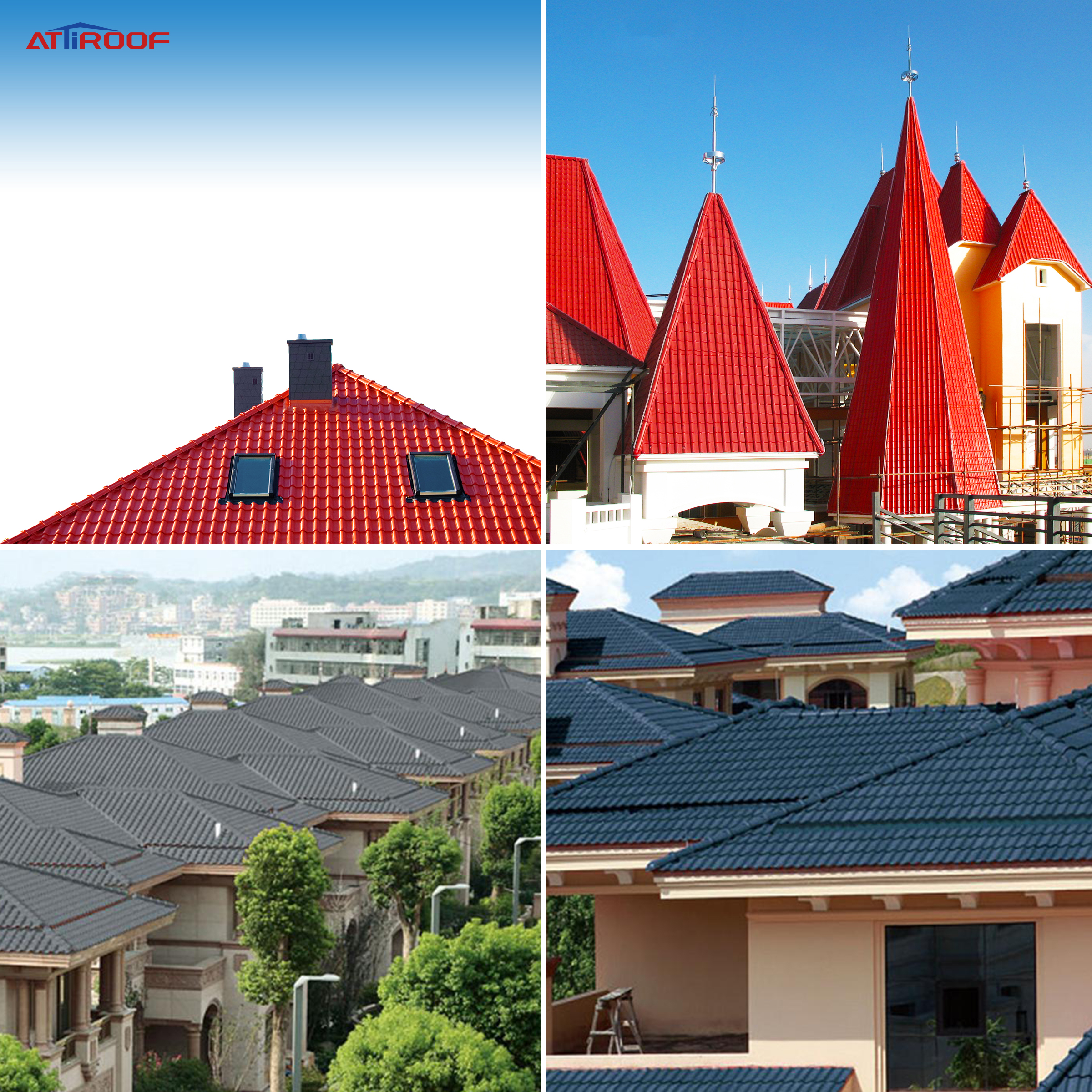
Data from the Environmental Protection Agency show an increased interest in weather-resistant building materials due to changing climate patterns. Synthetic resin tiles are particularly noted for their resilience in various weather conditions, making them an attractive option in regions prone to extreme weather events.
These data-driven insights are crucial for manufacturers to adapt and innovate their products. The trends indicate a significant opportunity for synthetic resin tiles, with a focus on eco-friendliness, durability, aesthetic flexibility, smart technology, affordability, and adaptability to climate changes.
The true testament to the value and versatility of synthetic resin roofing is best illustrated through real-world applications. This section, 'Case Studies: Transformations Achieved with Synthetic Resin Roofing,' delves into a series of practical examples, showcasing how synthetic resin tiles have been successfully implemented in various projects. These case studies highlight not only the aesthetic transformation but also the functional benefits they bring to both residential and commercial properties.
Synthetic resin roofing has revolutionized the residential roofing sector with its adaptability, durability, and aesthetic appeal. Here are a few examples where these tiles have made a significant impact:
1. Suburban Home Makeover:
●Project Overview: A 1980s suburban home with an outdated, weather-beaten roof.
●Transformation: The home was re-roofed with synthetic resin tiles that mimic traditional slate. This not only uplifted the home's curb appeal but also provided enhanced weather resistance and energy efficiency.
●Outcome: Post-renovation, the home saw an increase in property value and a reduction in energy costs, all while receiving compliments from the neighborhood for its refreshed appearance.
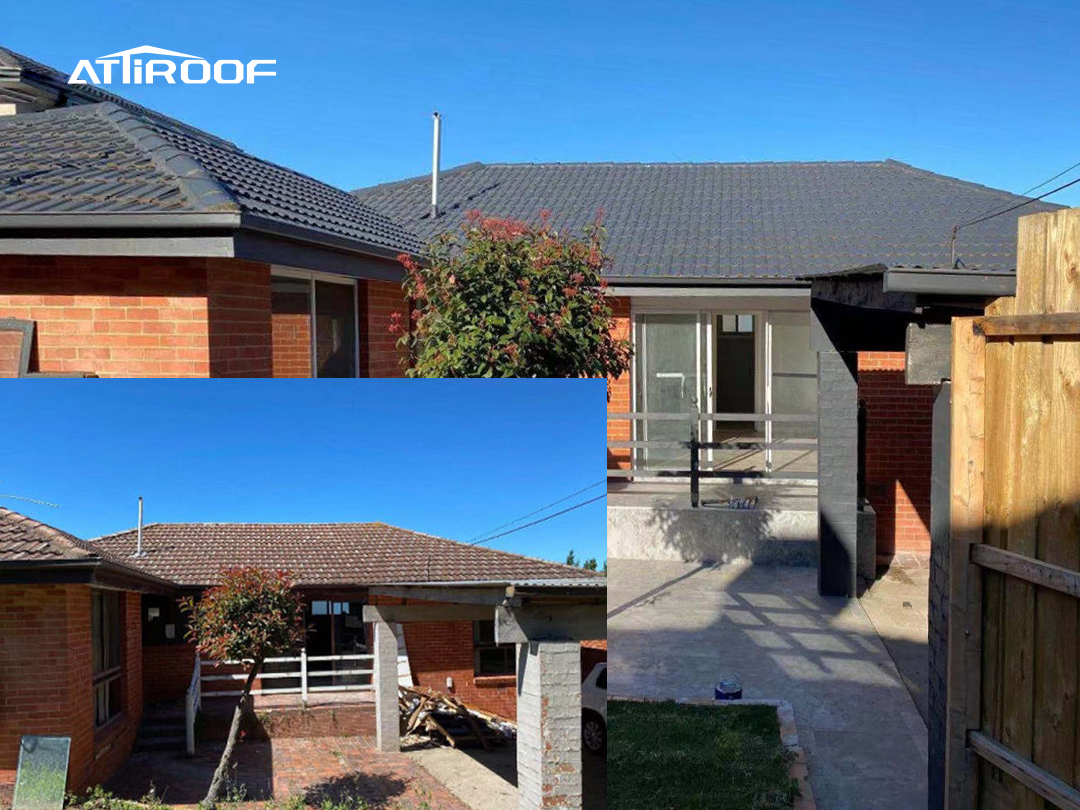
2. Historic Home Restoration:
●Project Overview: A century-old historic home needing a roof replacement that complied with local historic preservation standards.
●Transformation: Carefully selected synthetic resin tiles resembling classic clay were used to maintain the historical integrity of the home while providing modern benefits.
●Outcome: The restoration was applauded for preserving the historical look, and the homeowners benefited from the low maintenance and improved insulation properties of the new roofing.
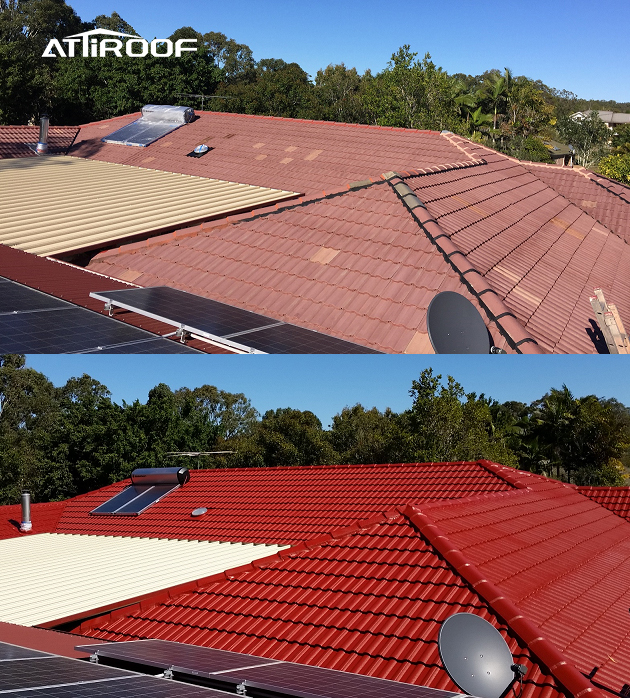
3. Modern Eco-Friendly Dwelling:
●Project Overview: A new construction aiming for sustainability and modern design.
●Transformation: The architects chose solar-integrated synthetic resin tiles, aligning with the home's eco-friendly ethos and sleek aesthetic.
●Outcome: The home achieved its goal of being energy-neutral, with the roof playing a crucial role in its energy production and efficiency.
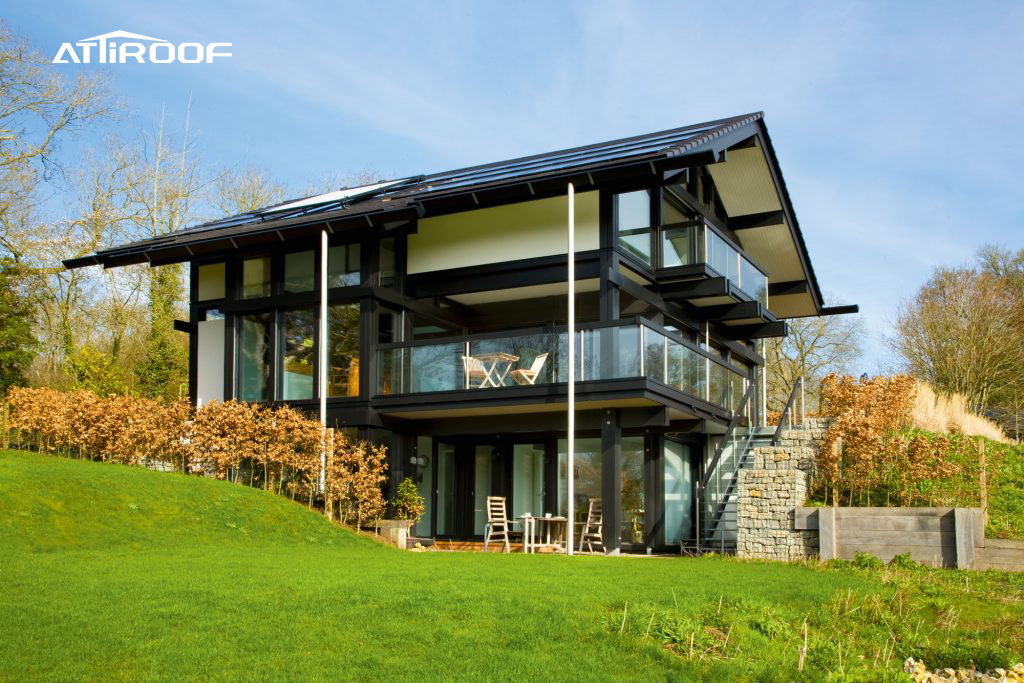
Each of these residential projects showcases the wide-ranging applications of synthetic resin roofing, from preserving historical charm to embracing modern sustainability, demonstrating how they can be tailored to meet diverse architectural styles and functional needs.
Synthetic resin roofing has not only transformed residential properties but also made a significant impact in the commercial and public sectors. Its versatility, durability, and aesthetic appeal have made it a preferred choice for various commercial and public building projects. Here are a few notable examples:
1. Retail Center Renovation:
●Project Overview: A dated retail center in need of a roofing overhaul to attract more foot traffic and tenants.
●Transformation: The center was outfitted with high-quality synthetic resin tiles that offered a modern yet timeless look. The tiles' lightweight nature allowed for easy installation without needing additional structural support.
●Outcome: Post-renovation, the retail center saw an uptick in visitors and new leases, attributed in part to its improved curb appeal. The management also reported reduced maintenance costs due to the durability of the new roof.
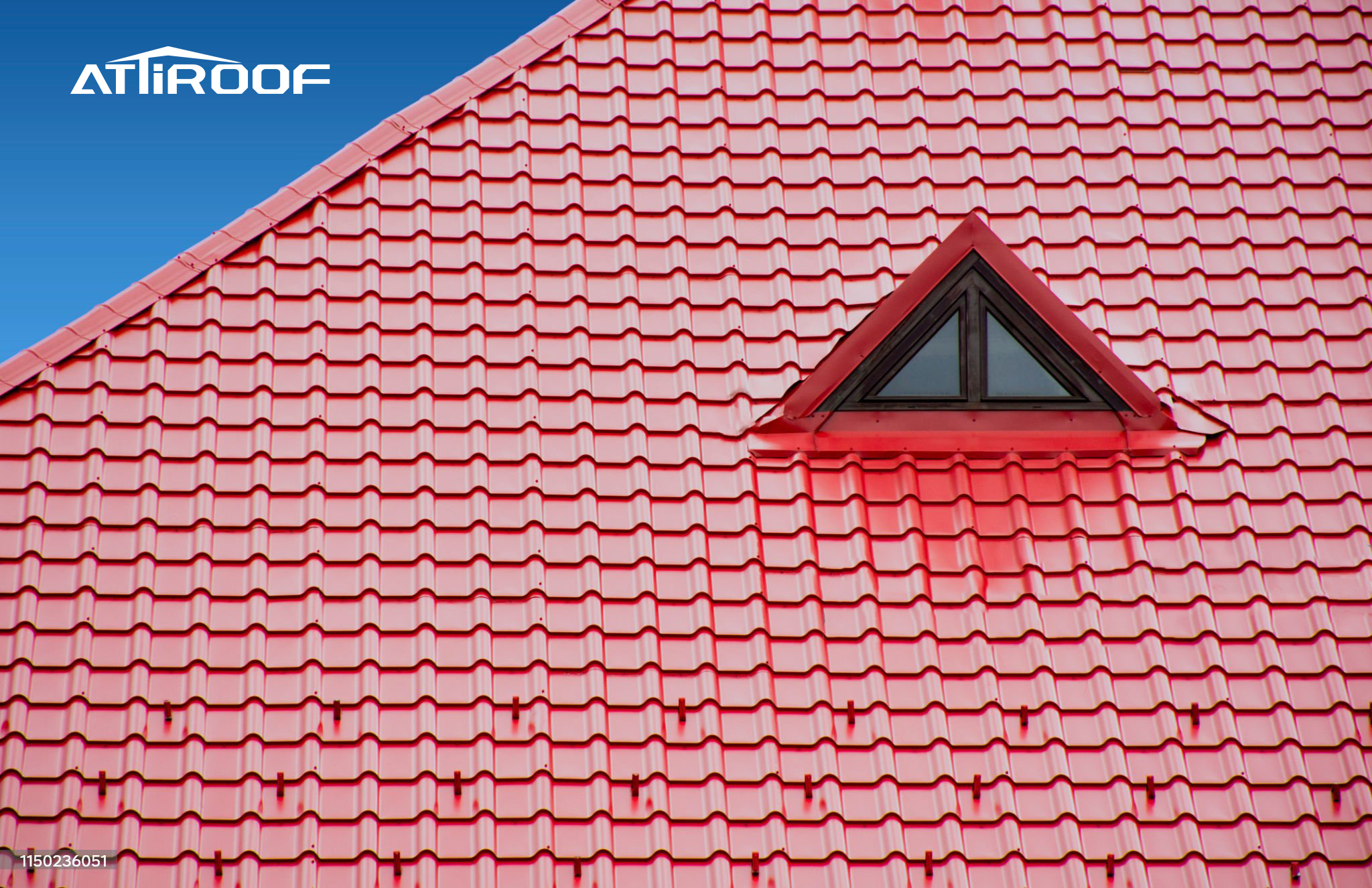
2. Historic Museum Upgrade:
●Project Overview: A historic museum required a roof replacement that adhered to its heritage status while providing modern protection.
●Transformation: Synthetic resin tiles that closely resembled the original slate roofing were used. This choice maintained the building’s historical character while offering enhanced protection and longevity.
●Outcome: The museum retained its iconic appearance, crucial for its historic value, while benefiting from a more sustainable and weather-resistant roofing solution.
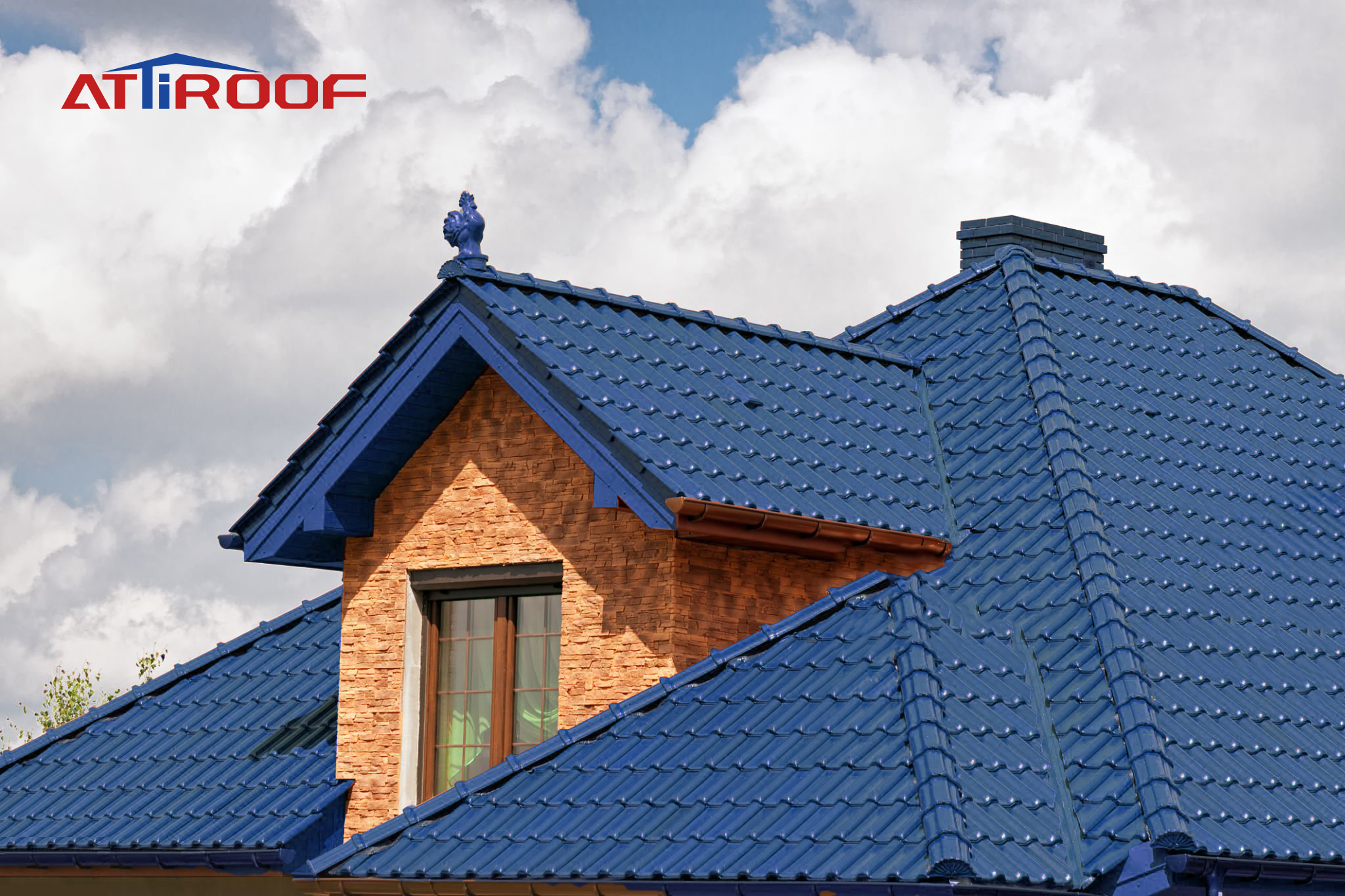
3. Eco-Friendly School Building:
●Project Overview: A new school building aiming to achieve a green building certification.
●Transformation: The architects opted for synthetic resin tiles with integrated solar capabilities, aligning with the school's commitment to sustainability.
●Outcome: The school achieved its green building goals, with the roofing playing a pivotal role in energy efficiency and environmental sustainability. The addition of solar functionality helped the school reduce its carbon footprint significantly.
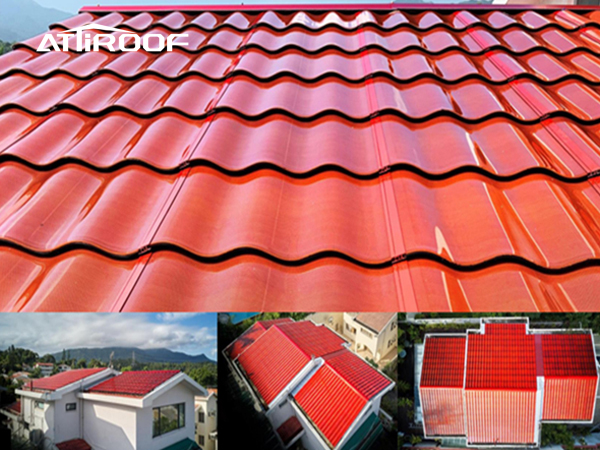
These case studies illustrate the adaptability of synthetic resin roofing in commercial and public settings, addressing unique requirements from aesthetic considerations to environmental sustainability. Whether for retail centers, historic buildings, or educational institutions, synthetic resin tiles provide a solution that combines form and function, proving their worth in large-scale applications.
The impact of synthetic resin roofing can be vividly seen through before and after comparisons of various projects. These transformations not only demonstrate the visual enhancement but also underscore the functional improvements achieved. Here are some illustrative examples:
1. Residential Home Upgrade:
●Before: An older home with faded and cracked asphalt shingles, contributing to poor curb appeal and inefficiency in energy use.
●After: The replacement with synthetic resin tiles gave the home a significant facelift. The new roof's sleek appearance and improved insulation properties enhanced both the home's aesthetic and its energy efficiency.
●Impact: The homeowner reported increased comfort levels due to better temperature regulation and a noticeable decrease in energy bills. The home's market value also increased, as noted by a local real estate appraisal.
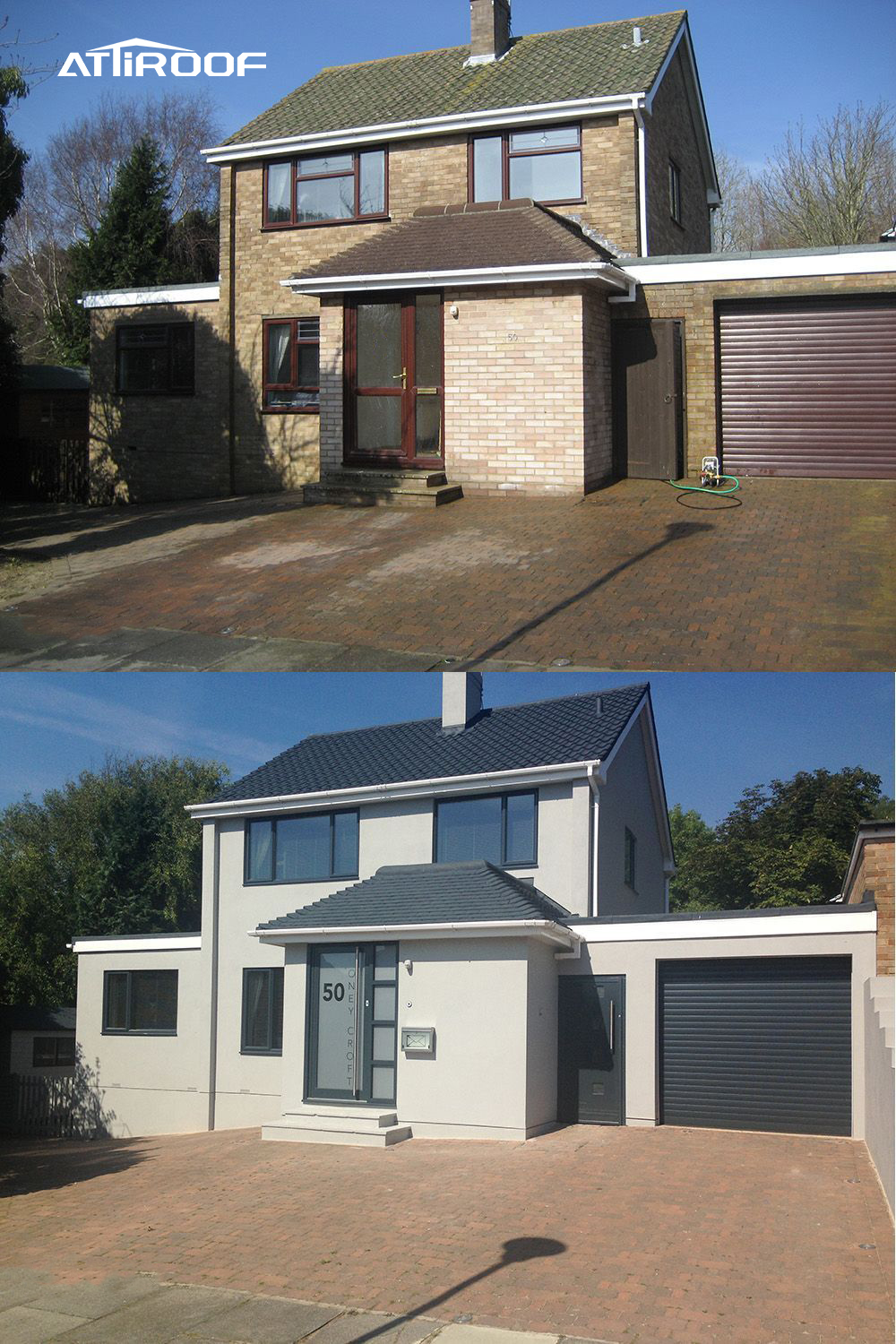
2. Commercial Building Renovation:
●Before: A commercial building with an outdated metal roof that was prone to rust and leaks, resulting in high maintenance costs.
●After: Post-installation of synthetic resin tiles, the building gained a modern and professional look. The new roofing provided better weather resistance and durability.
●Impact: The business owner observed a reduction in maintenance costs and received positive feedback from clients on the building’s improved appearance.
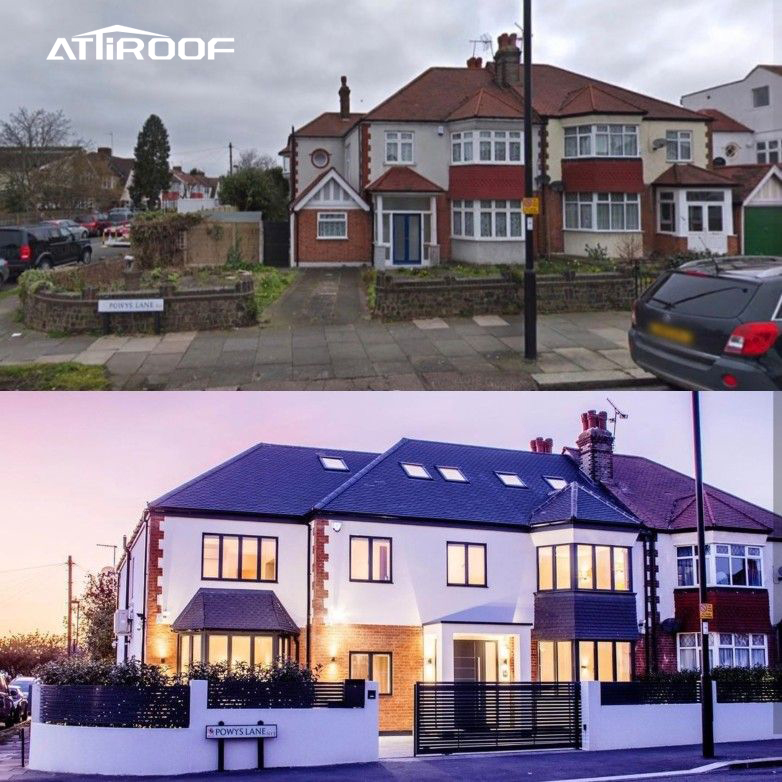
3. Historic Building Restoration:
●Before: A historic building with a deteriorating slate roof that was challenging and costly to maintain.
●After: The building was restored with synthetic resin tiles designed to mimic the original slate. This preserved the building’s historical integrity while providing modern benefits.
●Impact: The restoration was celebrated by the community for maintaining the historical look. The building managers appreciated the significant reduction in ongoing roof maintenance costs.
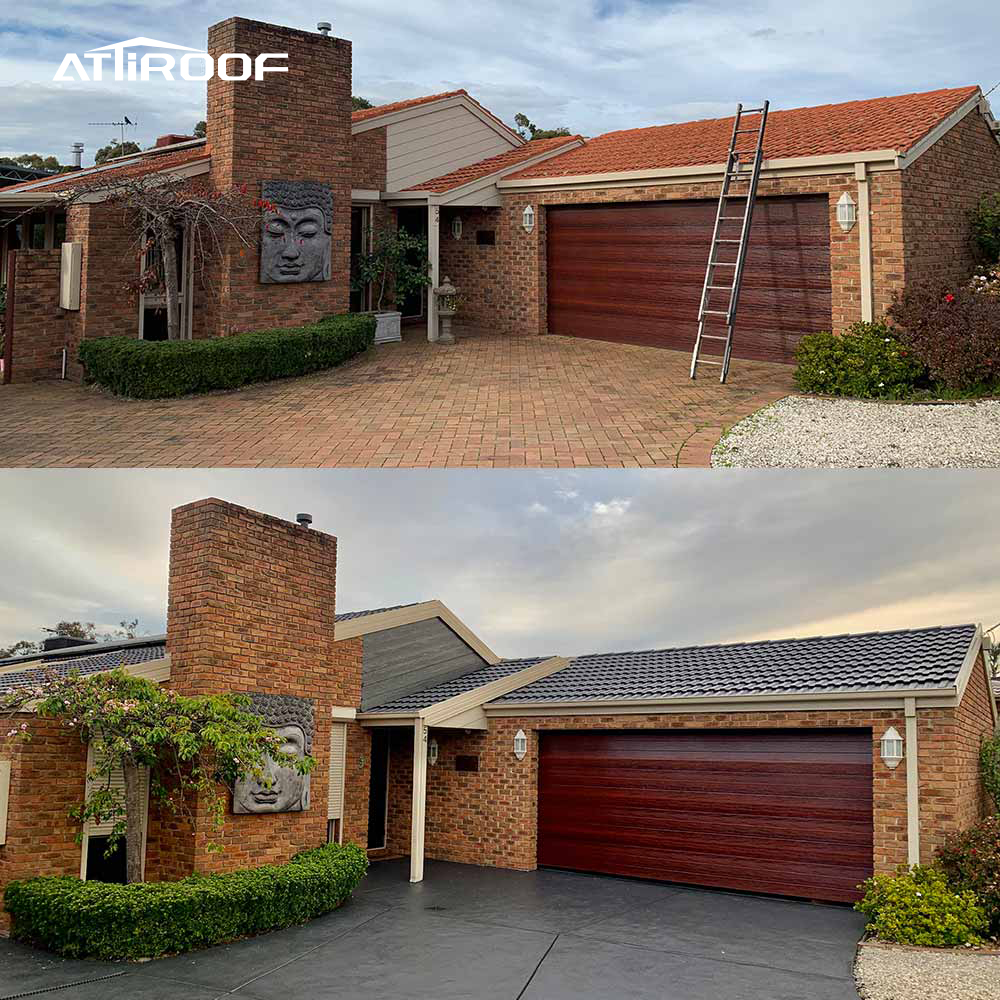
These before and after comparisons provide tangible evidence of the benefits of synthetic resin roofing. The transformations go beyond cosmetic improvements, offering enhanced functionality, reduced maintenance, and energy efficiency, making them a valuable investment for a wide range of properties.
As we explore the evolving landscape of roofing materials, it becomes increasingly clear that synthetic resin tiles are paving the way for a future that combines aesthetic appeal with functionality and sustainability. This concluding section reflects on the key benefits of these innovative tiles and anticipates the trends and developments we can expect to see in the industry.
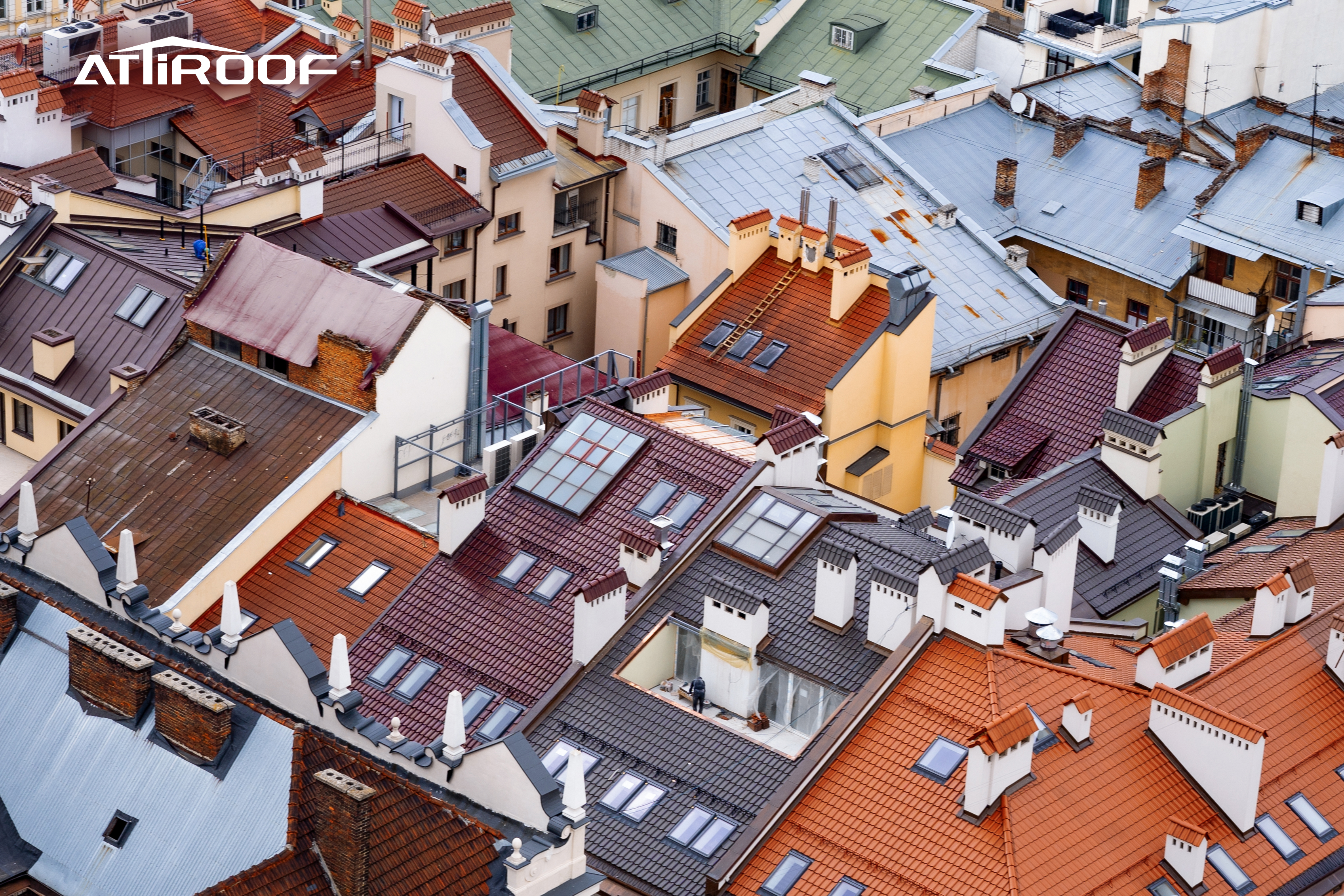
Synthetic resin tiles have emerged as a frontrunner in roofing solutions, offering a multitude of benefits that cater to diverse needs and preferences. Here are the key advantages that set them apart:
●Durability and Longevity: One of the most significant benefits of synthetic resin tiles is their durability. Resistant to cracking, fading, and weathering, these tiles can last for decades, far outperforming traditional materials in longevity.
●Aesthetic Versatility: With a wide range of styles, colors, and designs, synthetic resin tiles provide homeowners and architects the flexibility to achieve any desired look, from traditional to contemporary, without compromising on performance.
●Environmental Sustainability: The eco-friendly nature of these tiles is a considerable advantage. Many are made from recycled materials and are recyclable themselves, contributing to a reduction in waste. Their energy-efficient properties, such as heat reflection and insulation, also contribute to a lower carbon footprint.
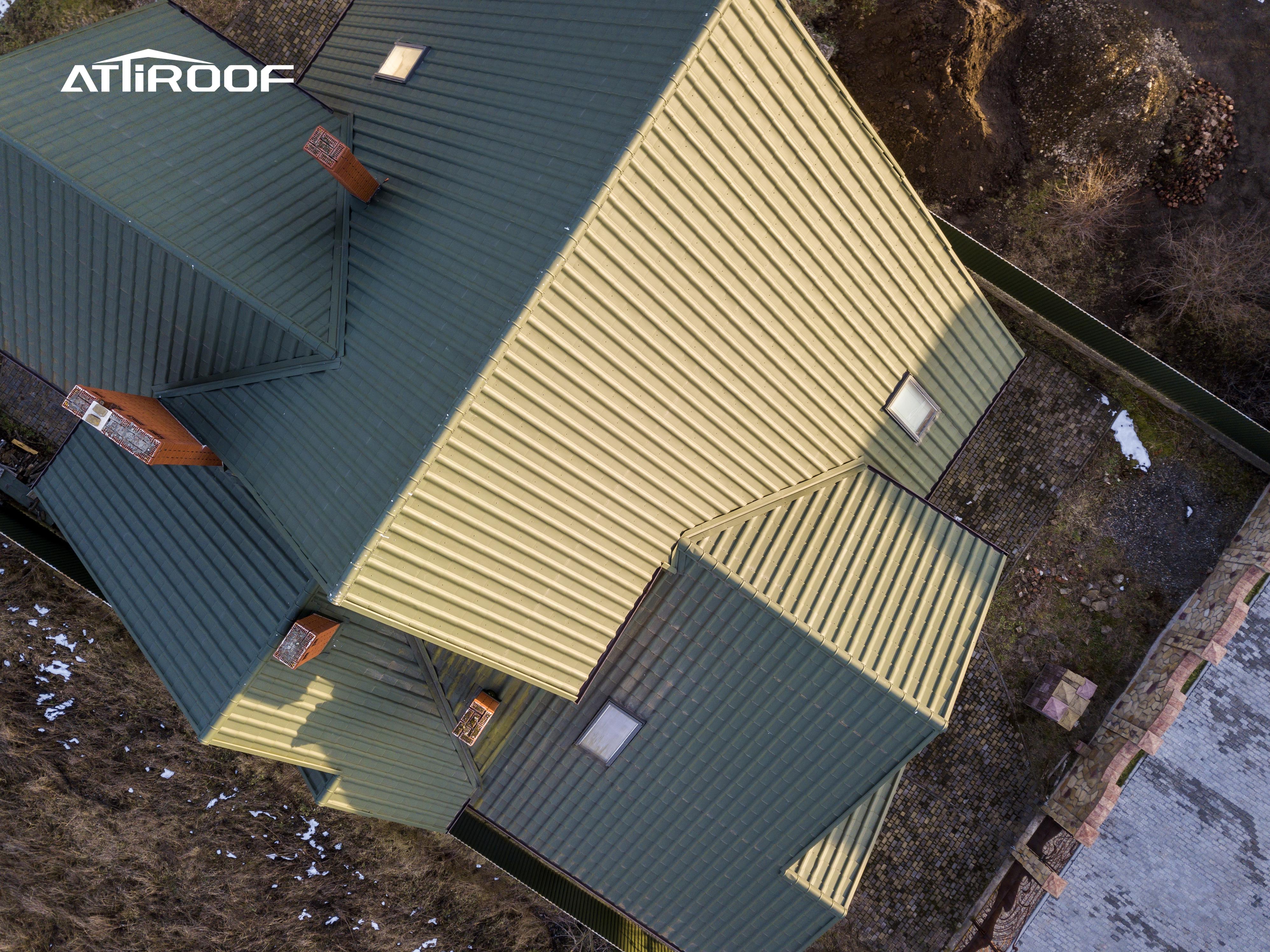
●Low Maintenance: Unlike some traditional roofing materials, synthetic resin tiles require minimal upkeep, saving time and money in the long term. Their resistance to algae, mold, and stains means they retain their aesthetic appeal with less effort.
●Cost-Effectiveness: While the initial investment might be higher than some alternatives, the long-term savings in maintenance, durability, and energy efficiency make synthetic resin tiles a cost-effective option over their lifespan.
●Adaptability and Safety: These tiles are adaptable to various climates and conditions. They are also fire-resistant and can contribute to the overall safety of a structure, an important consideration in fire-prone areas.
The combination of these benefits makes synthetic resin tiles not just a roofing material but a smart investment for the future. They align with the growing demands for sustainable, durable, and versatile building materials, making them a top choice for modern roofing needs.
As we look towards the future of roofing, synthetic resin tiles are set to play a pivotal role in the industry’s growth and evolution. Based on current trends and technological advancements, here are some predictions for the development of this sector:
1. Increased Market Share
The synthetic resin tile market is expected to see significant growth. Its share in the roofing industry is predicted to increase as more builders and homeowners become aware of its benefits. This growth will likely be driven by the material's versatility, durability, and sustainability.
2. Technological Integration
Future developments in synthetic resin tiles are likely to focus on integrating more advanced technologies. This includes enhancements in solar energy integration, smart sensor technology, and even more efficient manufacturing processes that further reduce environmental impact.
3. Focus on Eco-Friendly Solutions
As global emphasis on sustainability intensifies, the demand for eco-friendly roofing solutions will continue to rise. Synthetic resin tiles, particularly those made from recycled materials and designed for energy efficiency, will become increasingly popular.
4. Adaptation to Climate Change
With extreme weather events becoming more common, the industry will likely develop synthetic resin tiles tailored to specific climate challenges. This includes enhanced resistance to extreme temperatures, UV radiation, heavy rain, snow, and wind.
5. Expansion into New Markets
As the benefits of synthetic resin tiles become more widely recognized, their use is expected to expand beyond traditional markets. This expansion will include not only geographical growth but also application in a wider range of building types, from residential to commercial and public buildings.
6. Innovative Design Trends
The aesthetic versatility of synthetic resin tiles means they will continue to evolve in design, mimicking a range of natural materials and offering a broader array of colors and textures. This will cater to diverse architectural styles and consumer preferences.
The future of roofing with synthetic resin tiles is bright and promising. The industry is poised for growth and innovation, responding to the needs of a world that demands both functional and environmental efficiency in building materials.
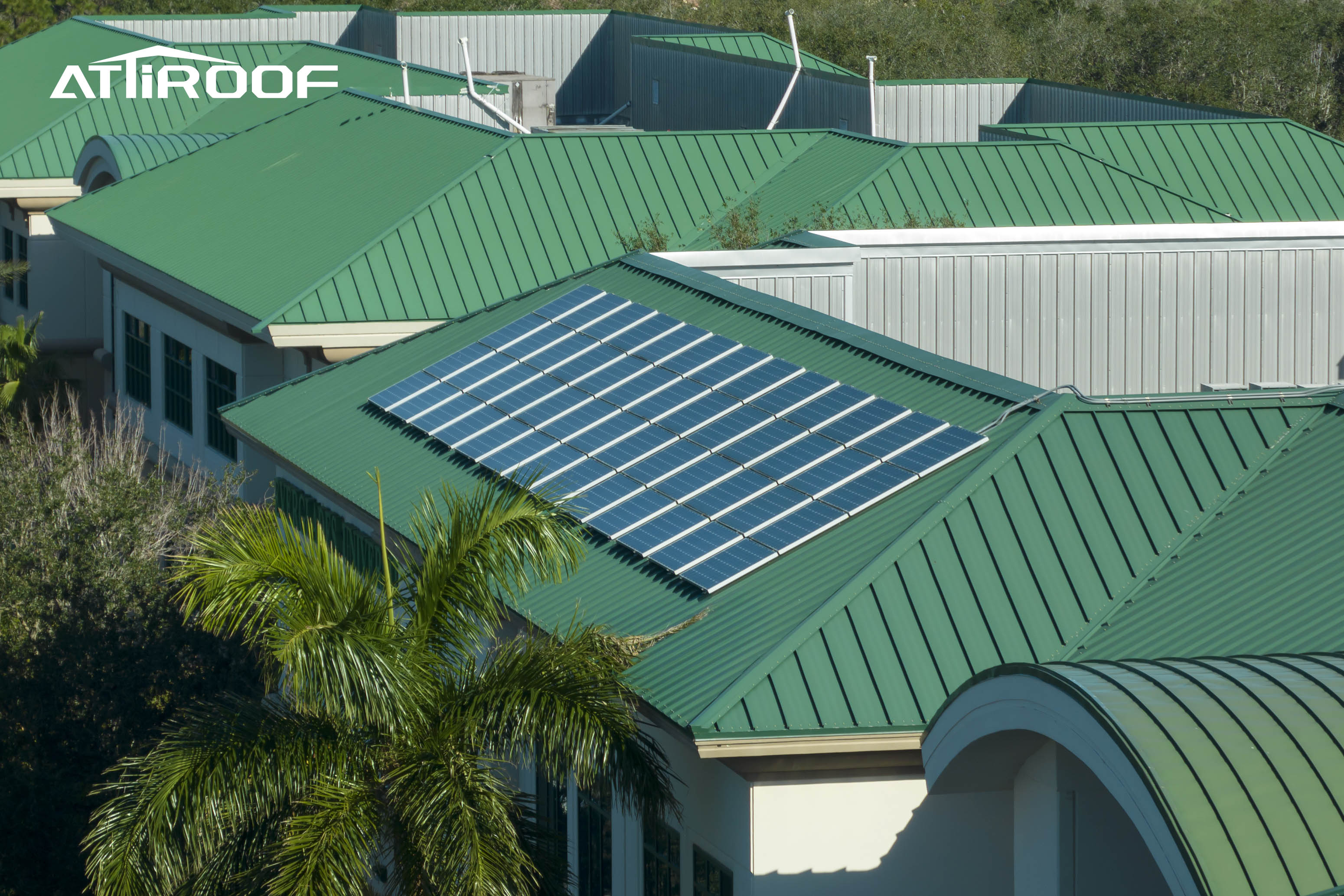
1. What is the average lifespan of synthetic resin roof tiles?
Synthetic resin roof tiles are known for their durability and can typically last over 50 years, far exceeding the lifespan of traditional materials like asphalt shingles. Factors such as climate conditions, installation quality, and maintenance routines can influence their longevity.
2. Are synthetic resin tiles environmentally friendly?
Yes, synthetic resin tiles are considered environmentally friendly due to several factors. They are often made from recycled materials and are recyclable at the end of their lifespan. Their durability means less frequent replacement, reducing waste. Additionally, their energy-efficient properties, like heat reflection, contribute to lower energy consumption in buildings.
3. Can synthetic resin roof tiles withstand extreme weather conditions?
Synthetic resin tiles are designed to be highly resilient in various weather conditions. They are typically resistant to extreme temperatures, UV radiation, heavy rain, snow, and wind. This makes them suitable for use in regions prone to harsh weather.
4. How do synthetic resin tiles compare in cost to traditional roofing materials?
While the initial cost of synthetic resin tiles might be higher than some traditional materials like asphalt shingles, they are generally more cost-effective in the long run. Their extended lifespan, low maintenance requirements, and energy-saving properties make them a financially viable option over time.
As we embrace the future of roofing, the role of synthetic resin tiles becomes increasingly significant. If you're planning a roofing project, considering a renovation, or simply looking to make an eco-friendly choice for your property, synthetic resin tiles offer an ideal solution. We encourage you to explore the possibilities these innovative tiles present. Reach out to Attiroof or your local roofing specialists to learn more about how synthetic resin tiles can benefit your project, both aesthetically and functionally. Join us in shaping a sustainable, efficient, and beautiful future for our homes and buildings. Take the next step in your roofing journey with synthetic resin tiles!
Previous post:None
Next chapter: The Comprehensive Guide to Gutter Systems for Roofing
Hot Products
Get in Touch With Attiroof
For top-tier, custom roofing solutions, trust Attiroof. Our commitment to quality and service is unmatched. Reach out to start your project today.